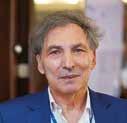

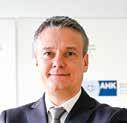
Grujić

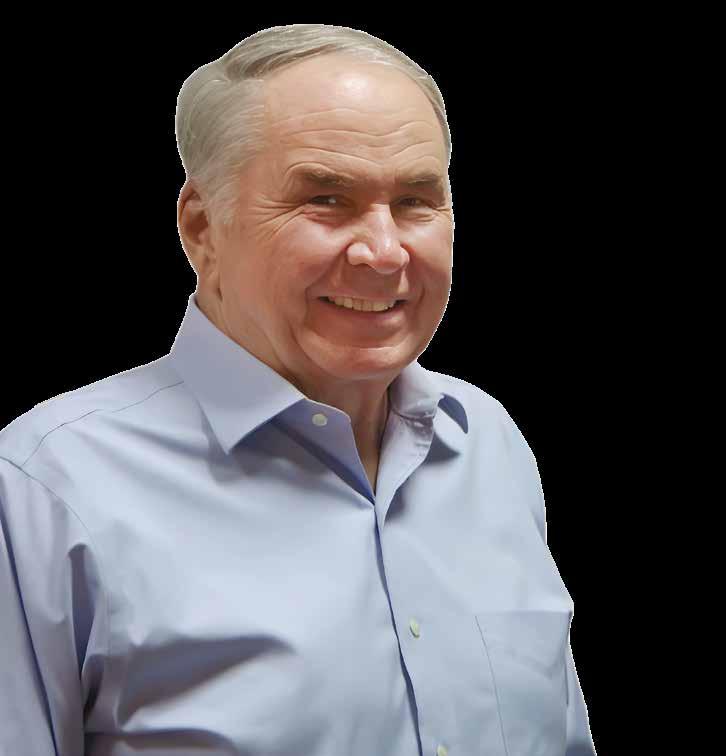






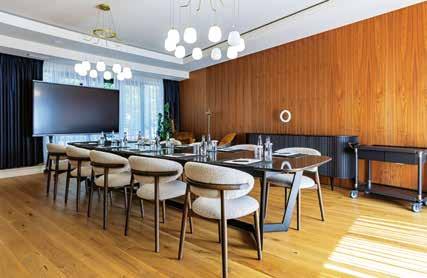
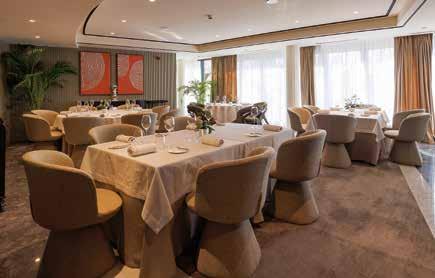
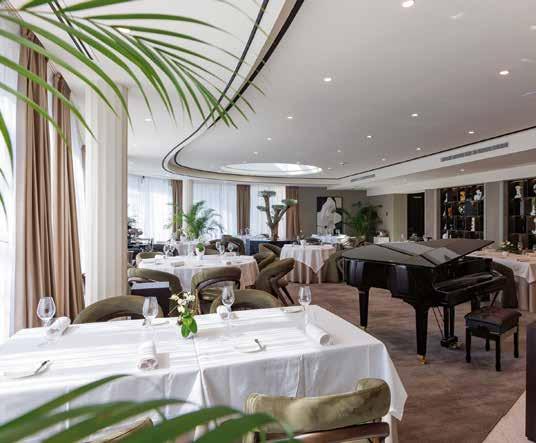
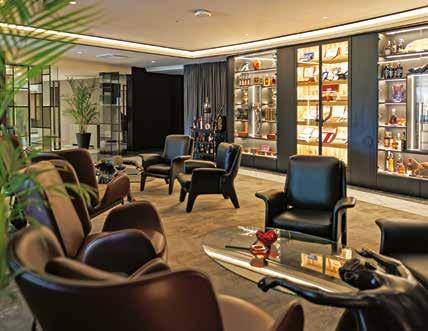
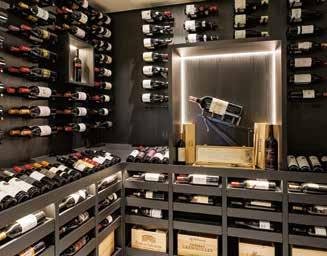
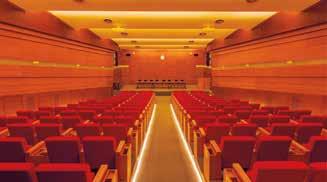
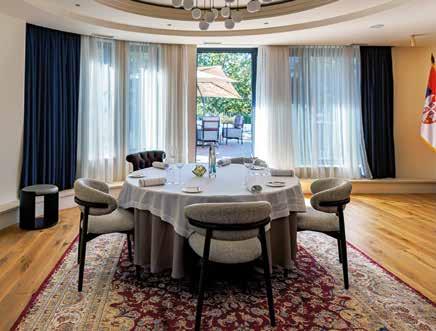




Grujić















Nestled in the heart of Belgrade, Tolstoy Members Club, an exclusive private club for selected members, occupies a historic building from the Yugoslav era, notable for its size and significance. Today, it blends rich tradition with contemporary sophistication, creating an atmosphere of timeless elegance reserved solely for its members.
Tolstoy highlights Serbian culinary heritage, elevating local flavors with refined techniques and international influences. Its wine list features a selection of the world’s most prestigious labels, alongside a significant number of exceptional Serbian archival wines from rare collections. The Club also offers an elegant cigar lounge and thoughtfully designed spaces for both business and social gatherings.
Combining Serbian authenticity with an international outlook, Tolstoy is a members-only destination where discretion, excellence, and a sense of belonging define every experience. A proud recipient of Wine Spectator’s Best of Award of Excellence, the Club ranks among the world’s most distinguished destinations for wine and fine dining.



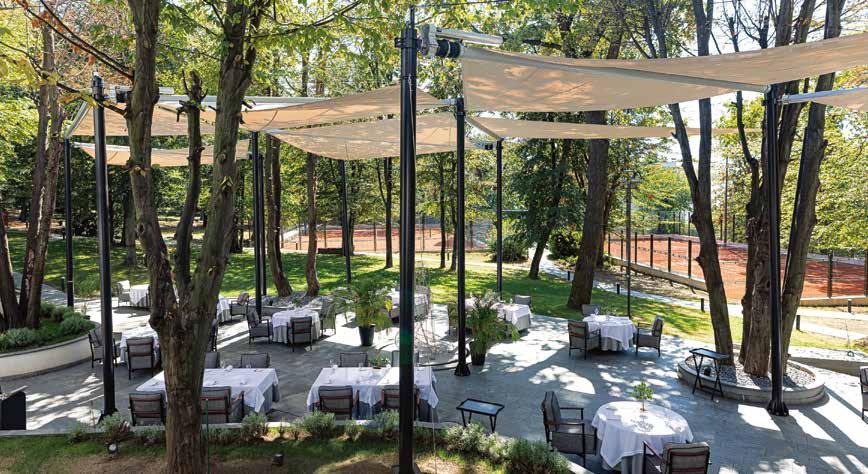
Ambassador William Montgomery and Dr Lynne Montgomery


Florida Atlantic University (FAU), Boca Raton, USA; Director, National Science Foundation (NSF) IndustryUniversity Cooperative Research Center for Advanced Knowledge Enablement, FAU 28
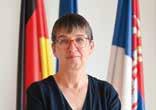


VISION MILAN GRUJIĆ
President of the German-Serbian Chamber of Commerce (AHK Serbia) 59 WIND IN THE SAILS DR IGOR KONČAR

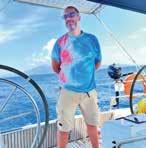
60 ADDIO MAESTRO GABRIEL FELTZ (1971–2025)

66 EVERY MAN CARRIES A CREATIVE SPARK SELMAN TRTOVAC artist

“CorD - 22 Years of Independent Thought and Inspiration”
EDITOR IN CHIEF: Neda Lukić n.lukic@aim.rs
DESIGN: Slađan Radosavljević Zoran Perović design@aim.rs
COPY EDITOR: Mark Pullen
TRANSLATION & EDITING: Pullen Editorial, Halifax
CONTRIBUTORS:
Ljubica Gojgić
Zoran Panović
Radmila Stanković
Maja Vukadinović
Mirjana Jovanović
Miša Brkić, Rob Dugdale
Steve MacKenzie
Zorica Todorović Mirković Sonja Ćirić, Miloš Belčević
PHOTOS: Zoran Petrović
SALES MANAGERS: Biljana Dević b.devic@aim.rs
Mihailo Čučković m.cuckovic@aim.rs
Vesna Vukajlović v.vukajlovic@aim.rs
OFFICE MANAGER: Svetlana Petrović s.petrovic@aim.rs
FINANCE: finance@aim.rs
CEO: Ana Novčić a.novcic@cordmagazine.com
PUBLISHER: Ivan Novčić i.novcic@aim.rs
PRINTING: Rotografika d.o.o. Segedinski put 72, Subotica
CorD is published by: alliance international media d.o.o.
Resavska 1/III, 11111 Belgrade 17, PAK 125806, Serbia
Phone: +(381 11) 2450 508
E-mail: office@aim.rs office@cordmagazine.com www.cordmagazine.com www.aim.rs
ISSN no: 1451-7833
All rights reserved alliance international media 2025
Cover photo by Željko Jovanović
Once a Miele, Always a Miele

Beograd | Bulevar Zorana Đinđića 64a Balkanska 2 | Bulevar Vudroa Vilsona 8, lok 17-18
Novi Sad | Žarka Zrenjanina 14
+381 11 22 77 111
info@miele.rs | www.miele.rs


By Boško Jakšić

Democracy seems to be suffering from COVID-19. Many rulers used the pandemic to restrict fundamental freedoms – of movement, assembly and speech – and are striving to retain those limits to this day. Institutions and civil society are deteriorating across great swathes of the world - from Central Europe to the Philippines and Bolivia. Censorship, surveillance and repression are on the rise

Wars, genocide, famine, inflation, refugees, dramatic social divisions, homophobia and the enigma of artificial intelligence together portray the world in which we live. It wasn’t long ago that people spoke of a crisis of leadership, recalling with nostalgia figures like Winston Churchill, Charles de Gaulle and Konrad Adenauer. What followed was a crisis of politics, marked by the rise of autocrats, populists, nationalists, demagogues and anarchists who skilfully exploited the mistakes of previous establishments and offered solutions that are seductive but unrealistic.
The logical outcome is a crisis of the liberal order. Democracy – which is always a blend of hope and discontent – has never been free from crisis, yet today’s crisis feels more perilous and accelerated. How did we move from Fukuyama’s “End of History”, proclaiming the permanence of the liberal system, to Joseph Stiglitz’s narrative of the dawn of the “End of Progress”? The financial and migrant crises played a decisive role. The former deepened inequality: in 2024, Tesla reported $2.3 billion in revenue but paid zero federal tax, while a Ugandan flour seller earning $80 a month paid 40 per cent, according to Oxfam. The latter enabled the easy sale of xenophobia, bringing about Brexit and the rise of “illiberal democracy” –
Across the globe, battles confirm how imperilled democracy has become and how much power right-wing populists and sovereigntists have amassed, cloaking themselves in conspiracy theories and victimhood
the cynical emergence of Hungary’s Viktor Orbán.
Across the globe, battles confirm how imperilled democracy has become, and how much power narcissistic right-wing populists and sov -


ereigntists have amassed, posing as victims through conspiracy theories. Political freedoms have fallen to their lowest in a quarter of a century. At least 112 countries have lost some rights, among them the U.S., Canada, South Korea, Japan, Australia and 20 of the EU’s 27 members. Dangerous polarisation is underway, with rising discontent and violence from Nepal to France.
More states are emulating the authoritarian models of Russia and China – Venezuela, Turkey, Egypt. In Israel, often styled as the Middle East’s only democracy, the prime minister faces genocide charges over Gaza while seeking to undermine judicial independence with far-right support. The self-styled leader of the free world itself risks capture by the autocratic ambitions of Donald Trump. U.S. relations with European allies are at their worst since WWII. America’s grand strategy as the guarantor of a unipolar world is unravelling, with China rising and Trump threatening to withdraw U.S. forces from Europe. Responsibility for Europe’s security is shifting, with the vacuum being filled by far-right movements from Germany and France to Austria and Portugal. And yet, perhaps not everything is bleak. As Ernesto Sabato wrote in The Tunnel: “The time that has passed, which seemed better, does not mean there was less evil, only that people fortunately forget.”
Welcome to the new world order.


































































































































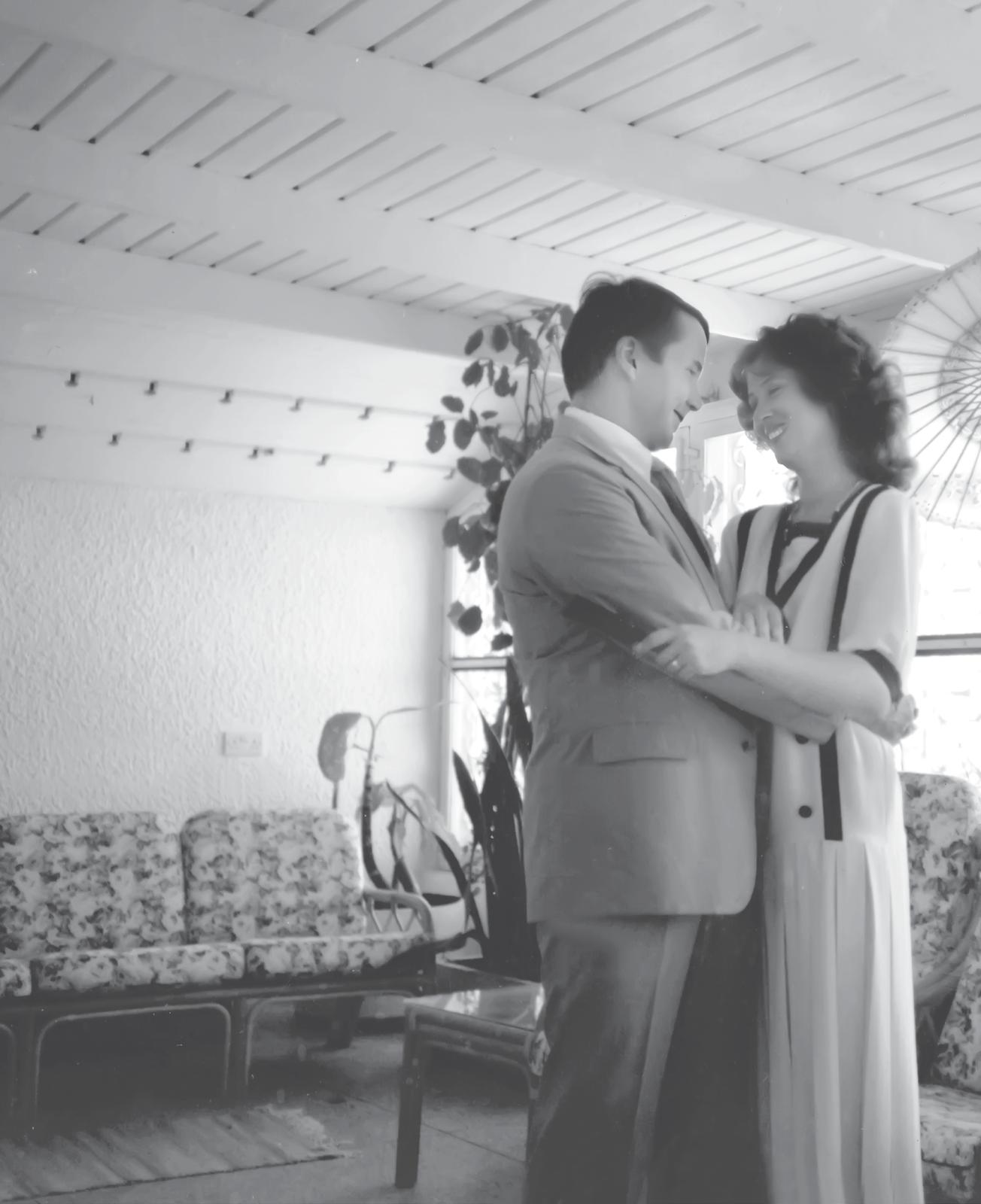
Ambassador William Montgomery and Dr Lynne Montgomery
By Ljubica Gojgić

I believe that, at the highest level, the European Union has a strong reluctance to accept any new member states. At the same time, lower levels of the EU continue to hold out the “carrot” of membership to encourage countries to change their policies. This policy worked earlier, when membership seemed likely and close. Not so much anymore. I don’t think any regional leader is willing to take strong and perhaps unpopular measures for an illusory EU membership sometime in the distant future ~
William Montgomery
U.S. diplomat William Montgomery spent a large part of his three-decade-long career in diplomacy posted to the countries of the former Yugoslavia, where he witnessed the most important events in the recent history of the Balkans. He writes about these events in his new memoir, entitled Un(diplomatic) Lives, published by CLIO. Just like his diplomatic style back in the ‘90s and the noughties, his recently published book is also attracting plenty of attention and comments around the region. Speaking in this interview for CorD Magazine, Montgomery explains why he doesn’t believe the Dayton Accords (Bosnia and Herzegovina)

and the Kumanovo Agreement (Kosovo) can endure without changes, as well as why he doubts that the countries of the region will join the EU in the near future. Like his book, this interview is also a joint effort, with his wife, Dr Lynne Montgomery, providing references to their private life, but also to important political events. Montgomery says that his wife “found many ways to complement my work, as well as the work of the U.S. government.”
You dedicated your book to your children and grandchildren. However, it also seems that you had a strong need to further clarify certain key historical events to the citizens of the region where you were officially posted for three decades, and where you chose to remain even after your diplomatic career ended.
— We believe that, in order to work towards a better future, it is essential to have a good understanding of your past. This is particularly true in the Balkans, which has had a difficult, controversial and violent century. We have seen how the same event can be understood and viewed very differently from country to country. We hope that our book can
be part of a much larger effort to view the past in a constructive way.
Dr Montgomery, readers who encounter your thoughts for the first time in this book will learn that you were far from a diplomat’s “silent spouse”, but rather you were a deeply engaged partner who complemented the work of your husband and the U.S. Government in many ways. You were also active in the region as a university lecturer and humanitarian worker.
As I look at Serbia and Croatia today, both have recovered significantly from the wartime experience, but more remains to be done and many remain traumatised by their experiences
How do you view our region today?
— You are absolutely right that there are many “silent” spouses who stay strictly within the confines of diplomatic life and believe strongly that is the correct way to behave. I entered American Diplomatic life at the age of 25 and it took me some time to have the confidence,
knowledge and imagination to engage differently. The key fact was probably that we were living in a region that had suffered terribly and the results of the war and destruction were still there for all to see. It seemed natural to try to help in Croatia with the problems of demining, exhumation and war damages. Similarly, in Belgrade it seemed natural to concentrate on improving medical care, building surgical rooms and combating cancer. I developed a small, cohesive team in both countries, using public and private fundraising methods. I also began teaching philosophy – first in Dubrovnik, then far more extensively in Belgrade. As I look at Serbia and Croatia today, both have recovered significantly from the wartime experience, but more remains to be done and many remain traumatised by their experiences.
Ambassador Montgomery, in your book you reflect on many key events in the recent history of the region. You witnessed the golden years of Yugoslavia in the late 1970s, followed by the war that led to its disintegration. You observed the implementation of peace in Bosnia and Herzegovina, the fall of Slobodan Milošević’s regime and the separation of Serbia and Montenegro. Judging by your writing, this list of challenges is far from being overcome. Do you believe the issue of Kosovo remains unresolved?
— The Dayton Accords were signed 30 years ago. The Kumanovo Agreement, which ended the NATO bombing campaign and decided the administration of Kosovo, was confirmed 25 years ago. Yet both Bosnia and Kosovo remain unresolved issues, with each having the potential for violence to erupt. I understand full well that reaching a satisfactory solution in either case is a very difficult, controversial job. But failing to try to address these issues condemns both regions to the status of failed states and an outbreak of violence. Given the U.S.’s role in both Dayton and the bombing of Kosovo, I believe that we cannot simply walk away from either issue.
What is actually heretical is sticking to the same old policies for three decades and expecting them to suddenly “work”
It is absolutely pathetic and maddening to see Western diplomats failing to recognise that new initiatives must be tried and solutions found.
You served as Special Advisor to the President and Secretary of State for Bosnian Peace Implementation from January 1996 until June 1997. Thirty years after Dayton, a question arises as to whether the peace agreement is ripe for revision. Your book proposes the somewhat heretical thesis that the solution in both cases could lie in referenda at the level of entities, with the results being duly recognised. — What is actually heretical is sticking to the same old policies for three decades and expecting them to suddenly “work”. Others are certainly welcome to suggest different alternatives, but I totally reject those who are happy and comfortable continuing down the same worn, discredited path that we’ve been on for so long.
Are you of the opinion that Montenegro will soon become an EU member? And do the other Western Balkan candidates have genuine prospects of accession?
— I believe that the European Union, at the highest level, has a strong reluctance to take any new members. At the same time, lower levels of the EU continue to hold out the “carrot” of membership to encourage countries to change their policies. This policy worked earlier, when membership seemed likely and close. Not so much anymore. I don’t think any regional leader is willing to take strong and perhaps unpopular measures for illusory EU membership sometime in the distant future.
How do you see the role of the U.S. in the region today? Is there space
the driving force for change in Serbia always came from the Serbian people themselves, often at great personal risk
The key question that hasn’t been sufficiently addressed by the student movement is what specific steps will follow “the day after”
for the Western Balkans on President Donald Trump’s agenda? — President Trump is a “disrupter” and is not afraid to challenge the status quo. I think this approach could be helpful in the Balkans. Thus far, however, his attention has been focused on other areas and it is unclear what his opinions are regarding this region.

en that the ruling party’s policies over the past 13 years have largely enjoyed the support of U.S. officials, both from the Trump and Biden administrations?

In the early 2000s, you found yourself in the unusual position of serving as the U.S. ambassador to Serbia while working in exile from Budapest. In the book, you also describe the support you extended to the opposition in preparing to overthrow Slobodan Milošević’s regime. Public opinion in Serbia remains divided over that period: some believe your embassy’s role was overstated, while others agree with your assessment and will likely look to your book for arguments supporting the claim that those protests –as well as today’s protests against the current regime – were “colour revolutions”. How do you view the current situation in Serbia, giv -
— First of all, the driving force for change in Serbia always came from the Serbian people themselves, often at great personal risk. While it is correct that the West provided various means of support to those efforts, nothing which outsiders did would have made a difference if the genuine discontent of the Serbian people was lacking. Western support was galvanised because the policies of Slobodan Milošević were a primary factory that led to the brutal wars of the 1990s in the region. The book describes in detail all the steps taken to support change at that time. When I look at the current strikes and blockades in Serbia, it reminds me exactly of the Otpor movement 25 years ago. While getting a lot of attention, public support and media coverage, it alone cannot bring about regime change. The key question that hasn’t been sufficiently addressed by the student movement is what specific steps will follow “the day after”.
Dr Montgomery, given that you lectured at universities in Croatia and Serbia, how do you perceive today’s student protests in Serbia?
— I enjoyed my teaching experiences tremendously, both in Croatia and Serbia. My interactions with so many bright, enthusiastic students was one of the highlights of my life. But I have been out of those positions and away from student life for considerable time now, and while I’m fully aware of the ongoing protests and “blockades,” I don’t have enough “on the ground” interactions with any side to give an informed view.
H.E. Anke Konrad German Ambassador to Serbia
By Ljubica Gojgić

Together with our EU partners, Germany expects full transparency in investigations into any allegations of excessive use of force and urges Serbia to uphold the fundamental rights of its citizens. Calls for adherence to the rule of law and for institutions to act in accordance with their mandate should be respected as calls for meaningful dialogue ~ Anke Konrad
Rejecting allegations made on multiple occasions claiming that Germany supports the anti-government protests in Serbia, Ambassador Anke Konrad says in this interview for CorD Magazine that “Germany is Serbia’s largest bilateral development partner”, adding that “it is no secret that we would like to see greater and faster progress in Serbia’s reform efforts towards EU accession”. The accession process is expected to gain new impetus at the next summit of the Berlin Process, which is being jointly organised by Germany and the UK.
Your Excellency, given that Germany celebrates its Day of National Unity in early October, what do you consider as the greatest challenges confronting your country today?
— The Day of German Unity is, and will remain, a very special event in German history. It has played a decisive role in the lives of many Germans, especially those from the eastern part of the country, including myself.
In celebrating the 35th anniversary of German reunification, we have a constant obligation to reflect on our journey since 1990. When the wall finally came down, a multitude of opportunities suddenly emerged – a freedom that many had long abandoned hope of ever experiencing. However, not everyone was able to benefit from these opportunities and many felt left behind. Embracing this challenge remains an ongoing task. Our society has grown closer over the dec-
ades, but divisions persist. Polarisation and populism continue to feed on these divisions. This is why dialogue across boundaries – even with those with whom we disagree strongly – is, and will remain, essential.
Moreover, we also face a multitude of challenges today: Russian threats to Europe’s security; challenges to the international order; and the growing dangers posed by climate change. These issues make it critical to strengthen our societies, our economies and our

ability to protect our citizens and their wellbeing. We need a strong and unified European Union in order to protect our shared values.
Research conducted by the German-Serbian Chamber of Commerce, published this spring, suggests that trade between Germany and Serbia is continuing to grow. However, to what extent might the current economic and political challenges confronting Germany influence the dynamics of economic cooperation moving forward?
— Our bilateral trade reflects the strong foundations of economic relations between Germany and Serbia. Bilateral trade reached a value of approximately €9.4 billion in 2024 and continues to grow, with Serbia achieving a trade surplus with Germany for the first time in decades. Despite the challenges posed by global economic shifts, German companies in Serbia are here to stay. Over 900 companies with German capital operate here, accounting for six per cent of Serbia’s GDP and providing employment to over 80,000 people. Their decision to invest in Serbia is driven by confidence in the country’s reliable business environment and steady progress on Serbia’s path towards the European Union. Sustaining this trust will depend on continued efforts to combat corruption, improve the efficiency of public institutions and ensure predictability in economic policy decisions.
You have stated that you are monitoring the protests in Serbia closely, stressing the importance of safeguarding the rights to freedom of expression and freedom of assembly, ensuring that violence must not occur and underlining the importance of the unhindered functioning of the judiciary. Do you believe these principles have been respected over the past ten months?
— We are closely monitoring the political situation in Serbia, as are our partners. The escalation over the last
few months is a cause for concern. Reports of threats and attacks against peaceful protesters, journalists and members of civil society, as well as all acts of violence, need to be investigated and those responsible must be held accountable. Everyone has the right to protest peacefully and to express their opinions freely, and it is the state’s duty to ensure that these rights are fully respected and protected. Together with our EU partners, Germany expects full transparency in investigations into any allegations of excessive use of force and urges Serbia to uphold the fundamental rights of its citizens. Calls for adherence to the rule of law and for institutions to act in accordance with their mandate should be respected as calls for meaningful dialogue.
The Serbian authorities view the protests of students and citizens as a “colour revolution” aimed at destabilising the country. Have you had the opportunity to discuss with Serbian officials the claims that Germany is among the countries sponsoring these protests, and what did you say to them in response? — These claims are absurd.
Germany and Serbia are closely connected through cooperation across a broad range of sectors. Germany is Serbia’s largest bilateral development partner. For the past 25 years, our two countries have been working handin-hand to foster innovation, improve the daily lives of citizens throughout Serbia and support the country on its path towards the EU.
The Serbian government was also criticised recently in the European Parliament, while your compatriot Manfred Weber, President of the European People’s Party, announced that the strongest political group in the European Parliament “is not blind to the recent events and images from Serbia,” and that, as a result, the membership of Serbia’s ruling SNS party in this group will be reconsidered.

Could developments in Serbia further delay the European integration process?
— It is no secret that we would like to see greater and faster progress in Serbia’s reform efforts towards EU accession. Progress is measured on the basis of tangible results. Germany remains a committed partner for progress, encouraging Serbia to seize opportunities such as the EU Growth Plan for the Western Balkans to advance further on its European path.
Germany and the UK signed a comprehensive cooperation agreement this July. Analysts have noted that part of the joint agenda relates to the Western Balkans, with London entrusted with revitalising activities within the scope of the Berlin Process this autumn. What will be the focus of attention for Germany and the UK in this region?
Over 900 companies with German capital operate here, accounting for six per cent of Serbia’s GDP and providing employment to over 80,000 people
— The United Kingdom is one of Germany and the EU’s closest partners. Our partnership is built on mutual trust and is essential to our security and prosperity. The comprehensive Friendship and Bilateral Cooperation Treaty signed between Germany and the United Kingdom in July 2025 marks a milestone in our relations, covering cooperation in defence, economic matters and foreign policy. A key focus of our collaboration is joint engagement in the Western Balkans. We are working together to address a wide range of issues aimed at bringing the countries of the Western Balkans closer to one another and closer to Europe as a whole. Our shared focus includes promoting regional stability, fostering economic integration through initiatives like the Common Regional Market and supporting reforms necessary for EU accession. This cooperation involves tackling security challenges, improving energy and transport connectivity and countering external influences that could undermine progress. By working together, we aim to empower the region to achieve lasting prosperity. In this spirit of cooperation, we are pleased that the United Kingdom is
Bilateral trade reached a value of approximately €9.4 billion in 2024 and continues to grow. Serbia has achieved a trade surplus with Germany for the first time in decades
hosting this year’s Berlin Process – a key platform for advancing regional cooperation in the Western Balkans. The Berlin Process tracks more than 10 years of growing interaction among Western Balkan States in many areas of common interest and continues to be an engine to foster development and the wellbeing of citizens in this region.
Your statement that lithium from Serbia “must be made available” because it is needed and important for both the European and German economies once attracted considerable attention and comments. You have since stated that relations be-
A key focus of our collaboration is joint engagement in the Western Balkans
tween Serbia and Germany “do not depend on the implementation of this project” and that it is not directly linked to Serbia’s EU accession. Does this signify a change in your view of the circumstances surrounding the possible opening of a lithium mine?
— To be clear: the decision on whether or not a lithium mine is opened in Serbia rests solely with Serbia. This has always been our position and there has been no change in our view.
In July 2024, the EU and Serbia signed a strategic partnership on sustainable raw materials, battery value chains and electric vehicles. The Jadar project, recognised by the European Commission in
To be clear: the decision on whether or not a lithium mine is opened in Serbia rests solely with Serbia
June 2025 as a strategic project, has the potential to generate significant economic benefits and create jobs while helping to reduce dependencies. It is clear that any development of this project must strictly adhere to high environmental, social and governance standards, with the full participation of all stakeholders to address the concerns of the local population. Germany is ready to support Serbia in this process and to share its expertise in sustainable mining, drawing on experience from our own project in the Upper Rhine Valley, which is also included on the list of strategic projects under the Critical Raw Materials Act.


Britain’s monarchy gave Donald Trump a welcome few leaders ever receive — a second full state visit, complete with all the pomp of Windsor Castle. King Charles hosted the U.S. president with a carriage procession, a military guard of honour, and a glittering state banquet under the castle’s vaulted ceilings. The symbolism was unmistakable: Britain’s royals placed their stamp of approval on a relationship meant to project strength and continuity. Behind the grandeur, Trump and Prime Minister Keir Starmer signed the “Tech Prosperity Deal,” worth billions in American investment. But even as trumpets played in Windsor, protests on London’s streets showed that royal pageantry cannot silence political division.
“Just write Giorgia… I am and always will be one of you, one of the people”
Giorgia Meloni


Conservative activist Charlie Kirk was shot and killed on September 10 while addressing an audience at Utah Valley University. The 31-year-old was answering a question about gun violence when a gunman opened fire, in what authorities called a political assassination. Kirk was best known as the founder of Turning Point USA, a movement that mobilised young conservatives and defended causes of faith, family, and traditional values. He often insisted on dialogue across divides, stressing the importance of debate even when opinions clashed. His sudden death has left both supporters and critics reflecting on the role he played in America’s turbulent political landscape.
The European Union is struggling to finalise its new emissions-cutting target ahead of COP30 in Brazil. Member states remain divided over how steep and fast reductions should be, with Germany, France, and Poland at odds over balancing climate ambition with industrial competitiveness. Officials are considering issuing only a “statement of intent,” proposing cuts of 66–72% by 2035, rather than a binding target. Climate campaigners warn such hesitation undermines EU credibility in global talks. For a bloc that once prided itself on climate leadership, delay now risks turning into embarrassment.


“The founding principle of democracy is that we voice our opinions”
Frank-Walter Steinmeier
Chancellor Olaf Scholz has pushed through a 2025 budget that marks a sharp break with Germany’s tradition of fiscal restraint. Nearly €116 billion will go into new investment, backed by a €500 billion infrastructure fund and increased defence allocations that bypass old debt limits. Scholz argues the move is essential to revive Europe’s largest economy and reinforce NATO commitments, especially with war still raging in Ukraine. Critics warn of looming deficits by 2027 and fear clashes over welfare spending. For Scholz, it is a high-stakes gamble to show that government activism, not austerity, will secure Germany’s future.


At Beijing’s Xiangshan security forum, China’s Defence Minister Dong Jun delivered a blunt message to the world. He warned against “the law of the jungle,” criticising Western alliances and foreign interference in Taiwan. His speech capped weeks of Chinese shows of strength, including the massive Victory Day parade. Analysts say Beijing is signalling it will defend its interests with force if necessary. The tone was unmistakable: China wants respect, on its own terms.
Scandinavia has been hit by an extraordinary summer of heatwaves, with temperatures soaring well above historical norms. Northern Finland saw more than 20 consecutive days above 30°C, conditions once thought impossible in the Arctic. Hospitals reported spikes in heat-related illness, while reindeer herds and fragile ecosystems struggled under the stress. Wildfires flared in forested regions, forcing communities to adapt to a climate that feels unrecognisable. For nations long defined by cold and snow, the heat has been a wake-up call that climate change is rewriting the seasons.

SCIENCE FOR SUSTAINABLE SOCIETIES
At the World Conference on Science and Art for Sustainability in Belgrade, leading scholars argued that politics, economics, culture and security must be understood through the prism of social and humanistic sciences. Their exclusive insights reveal how these disciplines can help shape sustainable societies for the future

At the end of September, Belgrade hosted the World Conference on Science and Art for Sustainability, a flagship event of the UN’s International Decade of Sciences for Sustainable Development. Among the themes discussed was the crucial question: How can the social and humanistic sciences contribute to shaping
sustainable societies through the understanding of politics, economics, culture and security?
The panel, moderated by Professor Dragan Đuričin, brought together distinguished international scholars including Prof. Alessio Surian, Prof. Dragan Simeunović, Prof. Fadwa El Guindi, and Prof. Nebojša Na -
kićenović. In exclusive contributions for CorD Magazine, they explored the transformative role of these sciences in times of global disruption – from the challenges of the polycrisis and the need for participation and interdisciplinarity, to new approaches in governance and science for a safe and just future.

Prof. Dragan Đuričin PhD
Advisory Committee for the Implementation of the International Decade of Sciences for Sustainable Development, UNESCO; World Academy of Art and Science (WAAS); Governing Board Member, Serbian Chapter of The Club of Rome
From polycrisis to green transition, the social and humanistic sciences hold the key to rebuilding trust, reshaping mindsets and creating sustainable societies
We live in an age of polycrisis, perhaps the most accurate term to describe the overlapping challenges of our time. Separate crises – economic, social, climate, biotic, geopolitical and psychological – have not only emerged simultaneously, but also interact and amplify each other. Since the dawn of economic neoliberalism nearly fifty years ago, the world has faced one major crisis per decade and hundreds of smaller shocks, leaving behind deep structural imbalances. Financialisation, deindustrialisation, indebtedness and growing inequality have been institutionalised as the “new normal”, while corrective mechanisms remain weak or absent.
The consequences of these imbalances are evident across three dimensions. In the physical world, we are witnessing global warming and the degradation of ecosystems due to the relentless overuse of natural resources. In the biosphere, feedback loops such as pandemics, shrinking biomass reserves and mass extinction of living organisms are reshaping life on Earth – in the past fifty years alone, around half of all living species have been lost. In the socio-economic system, widening disparities of income and wealth, fiscal deficits, short-termism in investment, indebtedness and the erosion of social cohesion have become defining features. In today’s $100 trillion global economy, the richest one per cent in the U.S. own more than 40 per cent of income, while public wealth has collapsed from 50 per cent of income at the start of neoliberalism to nearly zero today. Social consequences are dramatic: half of the working-age population in developed economies has been excluded from the benefits of growth.
At the same time, paradoxically, the understanding of frontier technologies – from artificial intelligence and quantum computing to synthetic biology – remains poor,
incomplete and unimplementable. Instead of being seen as opportunities, these breakthroughs are increasingly perceived as threats. Brain rot, driven by social networks and echo chambers, narrows people’s horizons, replacing critical reflection with the principle of “staying connected anytime, anywhere”. The outcome is the emergence of a surveillance state or network capitalism, in which it is less important to create or own something than to remain connected within the mainstream. What is not sustainable will not endure. The way out of the multi-crisis is through multi-transition,
What is not sustainable will not endure. The way forward lies in multi-transition, with the green transition at its core
with the green transition at its core, supported by circular models of growth and heterodox economic policies. But technological and economic measures alone are insufficient. Humanity needs a fundamental reset of mindsets, a new social taxonomy capable of linking sustainability of the economy with sustainability of the planet. This is where the social and humanistic sciences become indispensable. Their role is to rebuild trust in science, foster a resilient scientific culture, and enhance literacy through new tools such as AI. By connecting politics, economics, culture and security, these sciences create the intellectual and cultural framework for change. They can help overcome the ingrained dominance habit, restore cohesion, and turn scientific and technological breakthroughs into catalysts of sustainable societies rather than sources of fear and division.

Prof. Alessio Surian, PhD
Department of Philosophy, Sociology, Education and Applied Psychology, University of Padua; Member, UNESCO International Expert Group on Global Citizenship Education
The Club of Rome attempted to answer this question with the 1979 report No Limits to Learning, stressing the key role of participation in sustainable societies. Participation is more than the formal sharing of decisions; it is a democratic attitude characterised by anticipation skills and data, cooperation and dialogue
At the heart of dialogic learning are generative questions – not test questions, but those that do not have single answers, as they open up more questions and encourage intellectual humility and knowledge co-creation. From this perspective, a core contribution comes from Palestinian scholar and educator Munir Fasheh’s focus on the Arabic word al-muthanna (“YOU are, therefore I am, my existence depends on my relation with you”), which shows affinities with the Southern African concept of Ubuntu, one of the few that UNESCO took into account when mapping intercultural discourse. Al-muthanna refers to a relation between two people that becomes very important in both their lives and, at the same time, has a life of its own – almost like a common child. Such a relationship requires a slow pace of communication and observational abilities enhanced by sharing a specific place, through joint analysis of a shared territory. To flourish, it requires the ability to locate and question one’s own assumptions when confronted with cultural diversity. In other words, it suggests a rigorous and creative process similar to the participatory action research approach advocated and realised by Colombian sociologist Orlando Fals-Borda, to generate unlearning and commoning in relation to the persistent coloniality of knowledge and power (Quijano). The same coloniality is shaping the toxic extractivism, financialisation and securitisation that have dominated local territories and international relations since the Second World War. As neoliberal economy and militarisation tighten their grip, it is worth noting that most schooling still focuses on “paradigmatic” types of knowledge and neglects narrative knowledge, which is based on experiential learning.
According to scholars such as Jerome Bruner, narrative knowledge is the type of knowledge that relates to embodying culture and to understanding our present, generating a transformative potential that makes the learning process uniquely human. Bruner himself paid attention to the work of Lev Vygotsky in the 1920s and early 1930s on psychological and learning processes, which took into account not only the influence of social factors in general but also how each given context (family, school, social relations) plays a crucial role in shaping psychological and learning development.
Al-muthanna refers to a relation between two people that becomes very important in both their lives and, at the same time, has a life of its own – almost like a common child
These cultural-historical conditions were properly acknowledged by Orlando Fals-Borda, whose work is consistent with Vygotsky’s ability to observe how feeling and thinking are intertwined in every process of knowledge creation. Since the 1960s, this recognition of sentipensar (feeling-thinking) as the focus for developing dialogues that interrogate human relations within the framework of collective relations and their impact upon the local context has been at the basis of a variety of participatory action research and co-creation approaches, with a generative potential to re-connect territorial planning with its ecological and justice dimensions.

Prof. Dragan Simeunovic, PhD Faculty of Political Sciences, University of Belgrade
The role and even the very need for social and humanistic sciences are constantly being re-examined, yet their future relevance depends on embracing interdisciplinarity, prevention and social usefulness
From the end of the twentieth century until today, not only the role but also the need for the existence of the social and humanistic sciences has been continually re-examined, and their significance has been drastically disputed with varying degrees of subjectivity. The reasons for this are numerous. Society itself has inevitably changed, and thus the very meaning of the term society.
Globalisation has elevated profit to the highest pedestal, evaluating everything by profit and its magnitude – or its absence. The contribution of the social and humanistic sciences to generating profit is not always clearly visible, and therefore not easily measurable. In modern society, there is an apparent decline in demand, but that does not necessarily mean a diminished need for the scientific knowledge of the social and humanistic sciences and their interpretative role.
The change in the significance of these sciences is often confused with the need for their dissemination and relocation. The process of transforming their role is inevitable due to the accelerating pace of so-
The
cial life, which will increasingly orient these sciences towards prognosis and prevention – without abandoning the explanation of the past and present, nor their role in offering solutions to current problems. The emphasis will also fall on interdisciplinary and multidisciplinary research.
They can retain their significance only by approaching the natural sciences – not with the ambition of
role of social and humanistic sciences will increasingly turn towards prognosis and prevention, while retaining their interpretative function of explaining the past and the present
competition, or even equality, but with the ambition of greater social usefulness. By enhancing innovativeness and the more complex phronetic performance of their function, they will justify not only their existence but also their likely progress.

Prof. Fadwa El Guindi, PhD Board of Trustees, World Academy of Art and Science (WAAS); University of California, Los Angeles (UCLA)
The Shanghai Cooperation Organisation offers a platform for cooperation over chaos, while anthropology and the humanities provide tools to include cultures and traditions excluded by hegemonic narratives
The Shanghai Cooperation Organisation (SCO) held its annual summit in Tianjin, China, from 31st August to 1st September. Established in 2001 to strengthen cooperation among Central Asian states alongside China and Russia, it has since expanded to ten full members – including India and Pakistan – with observer states and 14 “dialogue partners”. The 2025 summit drew global attention with the presence of Russian President Vladimir Putin and Indian Prime Minister Narendra Modi.
At the summit, China and Russia presented their vision of a new international order. President Xi Jinping declared that “global governance has reached a new crossroads”, stressing the need to “take a clear stand against hegemonism and power politics, and practise true multilateralism.” President Putin echoed this, saying the SCO would revive “genuine multilateralism” and lay the foundations for a new system of stability and security in Eurasia.
Seen as an alternative to US-led institutions, the SCO includes much of Central Asia, Russia, China, India, Iran, Pakistan and Belarus, with dialogue partners ranging from Saudi Arabia to Turkiye. While it has been largely ineffective since its founding, the growing membership and Beijing’s backing with development finance suggest that may now change. Xi also outlined a “Global Governance Initiative” aimed at creating a parallel governance system outside the US- and European-led order.
The world has changed. Alignments of shared benefit emerging from Asia, Africa, Latin America and the Middle East challenge colonialist dominance over most of the world’s population. The SCO summit offers a platform of cooperation instead of endless chaos. Anthropology, the arts and the humanities provide alternative perspectives that highlight voices excluded from corporate and state media shaped by white supremacy. As I have described elsewhere, major events such as the World Cup in Qatar can “perform” cultural traditions alongside sport, while Egyptians experience their civilisation as a
Global governance has reached a new crossroads… we must take a clear stand against hegemonism and power politics, and practise true multilateralism
continuous identity interwoven of Muslim and Coptic threads. Science is not responsible for the world’s ills, but the absence of a relativistic view that embraces cultural diversity is. This orientation considers science an arena of exploration, imagination and evidence – as Einstein said, “Not everything that counts can be counted and not everything that is counted counts.” Including all peoples, cultures and nature is the path to sustainability.

Prof.
Distinguished Emeritus Scholar and former Deputy Director General, IIASA; Emeritus Professor of Energy Economics, TU Wien
Science must transform into an integrated, interdisciplinary endeavour to provide evidence-based advice and long-term vision in addressing the monumental challenges of our time
The world is facing monumental challenges: wars of unprecedented destruction, human suffering due to exclusion, economic crises and geopolitical disruption. These require evidence-based policy advice more than ever before. Science must be systemic, inter- and trans-disciplinary, integrated and holistic. Yet, because science is divided into disciplines – from the humanities and medicine to engineering and law – it too needs to transform.
Since the Industrial Revolution, science has made essential contributions to human progress. The global economy grew 100-fold, but carbon dioxide emissions rose 30-fold, leading to a mean global temperature increase of more than 1.5°C last year. The past five decades, often called the Great Acceleration, improved many lives but left billions behind without access to basic needs, while placing enormous pressure on planetary systems such as the climate and biodiversity. We truly live in the Anthropocene.
Science is needed more than ever, yet trust in science is eroding. Political cycles are short, while humanity’s problems require long-term vision and strategy. Science should act as a bridge between short-term interests and the pursuit of a safe and just future for all. To do so, scientific advice must be evidence-based, peer-reviewed, open, inclusive and independent.
Science also needs to speak a clear language. Critical discussions and controversies are essential, but advice must be comprehensible. As Kaldor noted, “stylised facts” can simplify complexity, and Einstein reminded us that things must be made “as simple as possible, but not simpler.” If we cannot explain them simply, it means we do not fully understand the problems.
Science should be a bridge between short-term interests and the pursuit of a safe and just future for all
A safe and just future for all requires disruptive and inclusive change in people, societies and values. This transformation must be supported by the digital revolution and the integration of innovations into new systems and human activities. An essential priority will be to develop science, technology and innovation roadmaps to navigate both the benefits and dangers of transformational change – for people and for the planet.
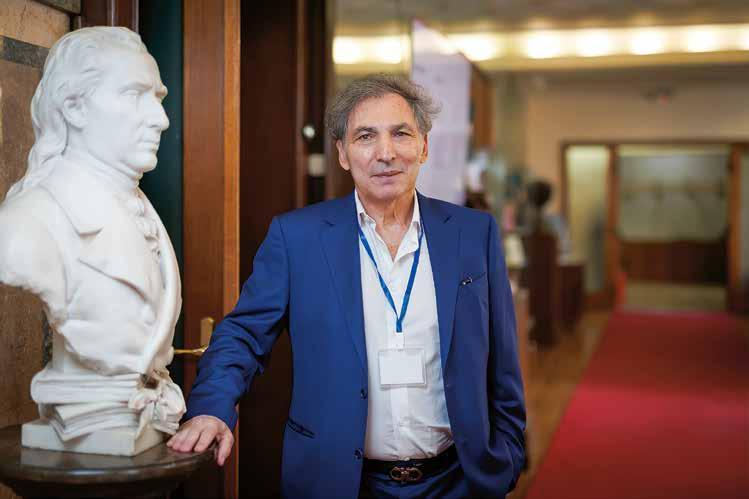
By 2040, AI will not just be a tool — it will be a partner in human progress, shaping economies, democracies, and cultures. Whether it becomes a force for universal empowerment or deepened division depends less on the technology itself and more on the principles and frameworks we build today
Borko Furht
Florida Atlantic University (FAU), Boca Raton, USA; Director, National Science Foundation (NSF) IndustryUniversity Cooperative Research Center for Advanced Knowledge Enablement, FAU
At the World Conference on Science and Art for Sustainability, held in Belgrade in September 2025, Professor Borko Furht, from Florida Atlantic University and Director of the NSF Industry–University Cooperative Research Center for Advanced Knowledge Enablement,
delivered a talk on the role of data science and AI in modern industries. On this occasion, he gave an exclusive interview for CorD Magazine, addressing the transformative impact of artificial intelligence on society, the economy, and global sustainability.
Artificial intelligence is transforming industries worldwide, from healthcare to finance. How do you see its most immediate and profound impact?
— AI assistants are already accelerating coding, contract review, data analysis and even creative writing. This reduces repetitive work and redefines what one person can achieve, multiplying productivity across industries.
Its most immediate impact is visible in three fields. In healthcare, AI enables earlier and more accurate diagnoses, bringing life-saving insights to patients who might otherwise go untreated. In finance, algorithms detect fraud in real time and help institutions make faster, safer decisions. And in everyday life, AI is amplifying human capability—whether analysing data, drafting documents or writing code.
In the short term, the benefits are efficiency, cost savings and broader access to expert-level services. But the deeper impact is long-term: AI is changing the very nature of work and decision-making, compelling us to redefine what it means to be human in a world where machines can think alongside us.
Data science is increasingly linked with sustainability goals. In what ways can AI contribute to addressing climate change and environmental challenges?
— Artificial intelligence is no longer just an industrial tool—it has become essential in the fight against climate change. By processing vast streams of data from satellites, oceans and the atmosphere, AI produces more accurate climate models and predictions of extreme weather, enabling communities to prepare and adapt before disaster strikes.
It is also transforming energy use. Smart grids balance supply and demand in real time, integrating renewable sources like wind and solar with greater efficiency, while algorithms optimise consumption in factories, buildings and transport systems, reducing waste and emissions. In agriculture, AI helps farmers achieve higher yields with less water, fertiliser and pesticides, protecting food security as well as ecosystems. Around the world, drones and sensors powered by AI are monitoring forests, oceans and wildlife to safeguard fragile environments.
The immediate impact is efficiency and savings. The long-term impact is far greater: AI is accelerating the tran-
sition to a low-carbon economy and equipping us with the intelligence we need to make sustainable choices— for our industries, our communities and our planet.
The future of work is being reshaped by automation and AI. Which skills should the next generation focus on to remain competitive?
— The future of work is not man versus machine, but how the two work together. As automation takes on more routine tasks, the skills that remain decisive are those that are uniquely human. Creativity, innovation and critical thinking will only grow in value, because while machines can process information, only people can connect ideas in unexpected ways or imagine futures not yet realised. Equally vital is emotional intelligence—the empa-
The future belongs to those who can use AI as a partner, not a replacement—and bring what machines cannot: imagination, empathy, and wisdom
thy and leadership that inspire teams, resolve conflicts and build trust.
Young people must also be fluent in the language of data and AI. Understanding how algorithms work, how to interpret their outputs and how to question their biases will become as essential as literacy and numeracy once were. Even if not everyone codes, computational thinking—the logic behind technology—will be a universal skill.
Adaptability will be the hallmark of success. The next generation must embrace lifelong learning, blending technical expertise with ethics, communication and cross-disciplinary collaboration. Ultimately, the future belongs to those who can use AI as a partner, not a replacement, and who bring to the table what machines cannot: imagination, empathy and wisdom.
Regulatory and ethical frameworks lag behind technological progress.
What principles do you believe are essential to ensure responsible AI adoption?
— Responsible AI adoption must be grounded in trust, fairness, safety, and accountability. At its core, it requires a kind of social contract for AI— where technological progress is balanced with human values and rights.
This means making systems transparent and explainable, ensuring accountability, safeguarding privacy, protecting against discrimination, and maintaining human oversight. It also means designing AI for safety, reliability, sustainability, and social good, while promoting international collaboration. These principles are not optional—they are essential if AI is to serve humanity responsibly.
Industry–university partnerships drive innovation and practical solutions. Can you share examples of successful collaborations from your NSF centre?
— The NSF Industry/University Cooperative Research Center for Advanced Knowledge Enablement (CAKE) has been built on partnerships that deliver real impact. Since its founding in 2009, CAKE has engaged dozens of corporate members and generated results that range from patents to prototypes and new talent pipelines. For example, in AI and data analytics, LexisNexis Risk Solutions worked with CAKE to create AI-driven text analysis and legal data mining tools that improved compliance monitoring while also training students. JM Family Enterprises partnered with us on predictive analytics for automotive finance, producing algorithms for customer retention and fraud detection.
In aviation, GA Telesis collaborated on predictive maintenance systems for aircraft components, cutting costs and improving supply chain reliability. In multimedia standards, global leaders such as Mitsubishi Electric, Cisco, Qualcomm, Adobe, and Google partnered with CAKE on next-generation video compression (H.266/VVC). These efforts resulted in 45 granted
U.S. patents, 11 of which were adopted as essential international standards.
CAKE has also worked on health and safety applications, developing in-vehicle sensor systems to detect early cognitive decline in older drivers, with potential for commercialisation by automotive and insurance industries. In operations and business intelligence, projects with Motorola and Google advanced big data analytics and trained a new generation of data scientists.
Across all of these collaborations, the outcomes are clear: patents and licensing revenues, working prototypes, published research, and a steady flow of highly trained graduates into leading companies. In short, CAKE bridges fundamental research with real-world implementation—delivering solutions that serve both science and industry.
At the Belgrade conference you spoke about the role of data science and AI in modern industries. Which key conclusions from your session would you highlight as particularly significant?
— One key conclusion is that today’s overvalued companies will face inevitable corrections, with some startups and investors losing heavily. But the AI winners that endure will not just succeed—they will dominate entire industries.
The areas of greatest impact are clear: productivity tools that reshape how people work, healthcare that delivers faster and more accurate diagnoses, and robotics that transform production and services. Together, these forces will define the next wave of industrial transformation.
You had the opportunity to visit Belgrade and take part in discussions on science, art and sustainability. What are your impressions of Serbia and where do you see opportunities for stronger cooperation in the field of AI and innovation?
— Serbia has three enduring strengths: an intellectual tradition rooted in great

AI is accelerating the transition to a low-carbon economy and giving us the intelligence, we need to make sustainable choices—for our industries, our communities, and our planet
scientific figures like Nikola Tesla and Mihajlo Pupin; cultural depth, shaped by its position between East and West; and the energy and talent of young researchers eager to engage globally.
Building on this, there are clear opportunities for deeper cooperation. In AI research and development, Serbian universities can expand ties with international centres, focusing on applied fields like healthcare, agriculture and energy. In startups and entrepreneurship, Serbia’s strong IT base could support new ventures in fintech, logistics and creative industries. The fusion of science, art and innovation offers unique ground for experimentation—from generative art to interactive performance. In sustainability and green AI, projects on smart cities, renewable energy and efficient machine learning could align Serbia
with international research priorities. And in education and talent mobility, exchange programmes and joint degrees could accelerate integration with global AI ecosystems.
In short, Serbia has the brains, culture and drive. What it needs is greater international integration and investment. AI and innovation could be the bridge that connects Serbia more deeply to Europe and the world.
Looking ahead, AI will evolve rapidly over the next decade. What is your vision of how it will shape society and business by 2040?
— By 2040, AI will be woven into every layer of society. In everyday life, digital assistants will anticipate needs, optimise routines and manage wellness, while smart homes and cities adapt services in real time. In healthcare, precision medicine will be the norm, with AI predicting disease long before symptoms appear and extending both longevity and quality of life. In education, AI tutors will democratise access, creating fully personalised pathways and supporting lifelong learning. And in ethics and governance, new global institutions will regulate AI much as the UN oversees international security.
For business, the “human-AI team” will be standard in every profession, from law to medicine to engineering. Industries will be reshaped: finance will run on real-time AI systems, manufacturing and logistics will rely on autonomous supply chains, and entertainment will blend reality with immersive AI-generated worlds. AI will become the ultimate competitive differentiator—companies without it will not survive.
The risks are real: concentration of power, massive shifts in employment, deepened inequality and even existential concerns if advanced AI is not aligned with human values. But the opportunity is equally profound: to create a society where human imagination, empathy and ethics work hand in hand with machines to build a safer, fairer and more innovative future.

Milan Grujić President of the German-Serbian Chamber of Commerce (AHK Serbia)

The German-Serbian economic relationship has shifted from cost advantage to a strategic partnership built on shared transformation
Although German-Serbian economic exchange faces pressures from inflation, labour market tightness and shifting global demand, Milan Grujić, President of the German-Serbian Chamber of Commerce (AHK Serbia), sees new opportunities that can deepen and transform this partnership.
How do you assess the potential impact of the German Government’s recently announced measures – such as fiscal expansion and the support package for start-ups – both on German companies in general and more specifically on their presence and further investments in Serbia?
— Germany’s decision to embrace fiscal expansion and strengthen its support mechanisms for innovation and start-ups is a clear signal of intent: Berlin wants to remain Europe’s engine of growth and innovation. For German companies, this creates a more predictable investment climate at home and accelerates the transition
to new technologies, particularly in digitalisation, green energy and advanced manufacturing.
For Serbia, this is highly relevant. A stronger, more innovative Germany naturally seeks to expand its ecosystem beyond national borders. Serbia, with its proven record as a reliable partner in supply chains, stands to benefit. German companies here can expect to see more opportunities to plug into value-creation streams originating in Germany’s innovation clusters. In practical terms, this could mean an expansion of R&D activities in Serbia, stronger demand for highskilled labour, and additional investments in advanced manufacturing capacities.
Which macroeconomic trends in Serbia are having the greatest impact on the operations of German companies already active here?
— Two stand out. The first is inflationary pressure which – while moderating – still influences both consumer demand and operating costs. For companies that serve not






just as exporters but also as local market players, purchasing power dynamics are critical.
The second is labour market tightness. Serbia has built its competitiveness on a skilled and cost-effective workforce. As wages rise – and as competition for talent intensifies – companies must rethink their talent strategies. Productivity gains and investment in human capital are more important than ever.
Additionally, energy stability and infrastructure modernisation remain cross-cutting themes. Reliable, affordable energy and efficient logistics will define Serbia’s ability to sustain competitiveness for German investors.
Considering the resilience of German-Serbian economic exchange, but also the expectations of a relatively large number of German companies that their business results will be weaker compared to previous years, what can we expect as we close this year and enter the next?



















— Resilience has been the defining feature of German-Serbian economic ties. Even in years of global turbulence, bilateral trade and investment flows have shown remarkable stability. That said, 2025 will likely close with a balance sheet of contrasts:
On one side, companies may report pressure on margins due to global demand fluctuations, supply chain adjustments and local labour costs. On the other, Serbia’s role as a hub in regional and European value chains will remain strong. The larger picture is therefore one of continuity – growth may decelerate, but the foundation remains solid.
For the year ahead, the outlook hinges on global recovery and the pace of structural reforms in Serbia. If both align positively, German-Serbian business ties will not only remain resilient but expand into higher-value domains.
German companies most often choose Serbia as an investment destination due to its skilled yet affordable workforce, while at the same time Germany continues to improve conditions for the recruitment of professionals from Serbia to Germany. How do these two trends affect the ability of your members to attract and retain the workforce they require?
— This is one of the defining paradoxes of our relationship. Germany needs talent, and Serbia has it. Mobility is therefore both a risk and an opportunity.
For German companies operating in Serbia, the challenge is retention. But the solution is not to limit mobility – it is to make staying equally attractive. That requires creating more than jobs; it requires creating careers. Companies that invest in professional development, leadership tracks and work environments that reflect international standards will not only keep talent but inspire loyalty.
At the same time, mobility creates circulation of knowledge. Professionals who gain experience abroad and return to Serbia bring fresh perspectives, skills and networks. If Serbia leverages this, what appears to be a challenge can, in fact, be transformed into a strategic advantage.
Taking into account the highly complex trends at both global and regional economic levels, what, in your opinion, are

E-mobility, renewable energy and digital services are the key industries set to drive deeper German-Serbian economic cooperation
the best-case scenarios when it comes to attracting new German investments?
— The best-case scenario rests on two pillars: policy consistency and talent development.
If Serbia continues to advance reforms –particularly in rule of law, regulatory predictability and EU alignment – German companies will see reduced risk and higher long-term returns. That is the single most powerful magnet for investment.
The second pillar is human capital. Serbia has the opportunity to position itself not just as a cost-competitive location, but as a centre of excellence in selected industries: e-mobility, IT, renewable energy and advanced manufacturing. Developing education, vocational training and dual systems tailored to these needs is crucial.
In this scenario, workforce numbers can grow not just in quantity but in quality. That is how German investments will evolve from labour-intensive to knowledge-intensive, ensuring long-term sustainability.
Which industries do you see as key drivers of stronger economic relations between Germany and Serbia?
— Three stand out clearly.
First, e-mobility and automotive transformation. As Germany retools its automotive sector for an electric future, Serbia –already a hub for components and systems – will be drawn deeper into the value chain.
Second, renewable energy and green technologies. The energy transition is no longer optional. German companies are global leaders here, and Serbia’s need for investment in renewables makes this a natural field of cooperation.
Third, digital and IT-enabled services. Serbia has talent, Germany has demand. Bridging the two will create not just outsourcing models, but integrated digital ecosystems.
If you were to highlight specific areas where EU integration matters most, what would you single out as the greatest achievements of the past and the key priorities for the period ahead?
— EU integration is not just a political process; it is an economic accelerator. Alignment with EU standards reduces transaction costs, increases predictability and makes Serbia part of the European business fabric.
The greatest achievements so far lie in trade liberalisation and the gradual harmonisation of technical standards. These have allowed German companies to operate here as seamlessly as in other EU markets.
The priorities ahead are clear: judiciary reform, stronger institutions and transparent regulatory frameworks. These are not abstract concepts – they directly affect investor confidence, contract enforcement and the ability to plan long term.
For German companies, progress in these areas will determine the scale and scope of future investments. For Serbia, they will determine the speed of convergence with the European economy.
The German-Serbian economic relationship is no longer defined by cost arbitrage; it is defined by shared transformation. Germany is reshaping its economy, Serbia is redefining its growth model. Where these journeys intersect lies the future: a partnership not of necessity, but of choice and strategic vision.

Nemanja Ćirić General Manager, Omega Properties

On a 26.5-hectare site located between Paraćin and Ćuprija, right next to the motorway, we are planning to develop an innovative mixed-use business park. The park will comprise of a Commercial Zone, a Production & Industrial Zone, a Logistics Zone, and a Start-up Zone
People have always cared about the environment in which they spend their time – the surroundings in which they live, the places where they work, and the spaces where they enjoy leisure time with their loved ones. These environments have changed throughout history under the influence of various events, trends and inspirations, but their importance has never diminished.
The development of technology, together with the globalisation of the world, has also influenced the way our environments evolve and change. Until now, the prevailing concepts have placed production and industrial facilities in impersonal zones that rarely offer workers anything beyond endless parking lots. Logistics parks have been focused solely on motorway access. Spaces for start-up development are scarce, while retail parks – intended as leisure spaces – are often built to formula and end up looking identical.
Our team at Omega Properties recognised the need for new concepts and new environments. What is needed is a unique space that combines modern production facilities, convenient motorway access for logistics purposes, inspiring start-up zones for developing cutting-edge technologies, and a commercial zone where families can spend quality time together.
Through a detailed analysis of Serbia and the wider Balkans, we identified that such spaces simply do not exist. That is why we

General Manager, Omega Properties
Omega Properties offers a unique environment that unites state-of-theart production, efficient logistics, inspiring start-up spaces and a commercial zone for families
began our search, and in the town of Paraćin, at the very heart of Serbia, we found the location we intend to transform into precisely
such a unique environment. On a 26.5-hectare site between Paraćin and Ćuprija, right next to the motorway, we are planning to develop an innovative mixed-use business park. The park will comprise of a Commercial Zone, a Production & Industrial Zone, a Logistics Zone, and a Start-up Zone.
The Commercial Zone will include a retail park and other commercial facilities designed with spatial quality in mind. The Production & Industrial and Logistics Zones will consist of facilities constructed in line with the latest international building standards, applying the principles of green architecture and striving towards carbon-neutral operations. The Start-up Zone will be inspired by the innovative campuses of the world’s leading technology companies.
The production, industrial and logistics facilities will be built according to user requirements under a build-to-suit model, with a predominant concept of long-term leasing. This approach will ensure sustainable economic development for renowned companies, the residents of Paraćin and neighbouring areas, as well as for the business park itself – all within an innovative environment that provides everything in one place.
Our ambition is for this to be the first of many innovative business parks that will transform the way we live, work and spend our leisure time, and we believe that our vision will be followed by many others in the future.

Since 2016, in cooperation with over 30 private companies, Deutsche Gesellschaft für Internationale Zusammenarbeit (GIZ) GmbH has initiated 21 projects in Serbia and across the Western Balkans, with a total volume of €29 million. These projects support governments and municipalities primarily in digital transformation and the green transition, enabling German, European and local companies to enter new markets and promote the sustainable products and services they offer.
Together with its partner organisations, GIZ has supported the development of better investment conditions and the improvement of a business-friendly climate in municipalities throughout the region.
“Withourwiderangeofcontactsaround theWesternBalkansand25yearsofproven experience, we help pave the way for German, European and international compa-
nies looking to do business in Serbia and the whole region,” says Zoran Jakovljev, Project Manager at GIZ.
Having GIZ as a reliable business partner in the implementation of joint projects in the region allows for greater local presence, providing access to networks, policymakers, civil society and academia. GIZ offers customised advisory support from the generation of project ideas and fundraising to project implementation, positioning the organisation as a unique one-stop shop for integrated solutions to global challenges.
With access to specific data and regulatory knowledge, GIZ strengthens supply chains for private companies while at the same time fostering knowledge transfer and boosting innovation. Moreover, GIZ offers
a wide range of services to the private sector, from creating strong partnerships and networks with all relevant players to building the capacities of public institutions, improving the regulatory framework and removing business barriers.
GIZ’s strategic priority is to increase cooperation with the private sector, recognising its vital role in driving innovation, investment and scalable impact. By aligning development goals with business interests, GIZ aims to foster partnerships that deliver sustainable, market-oriented solutions across sectors.
“WeinviteGermancompaniestopartnerwithusandleverageGIZ’sexpertise and network to secure their long-term interests and co-create a sustainable future for the Western Balkans.”
With develoPPP, the German Federal Ministry for Economic Cooperation and Development (BMZ) promotes private-sector activities where entrepreneurial opportunities and development policy potential meet. Companies that want to invest sustainably in a developing or emerging country and expand their local operations can receive financial and technical support under the programme.
www.developpp.de

The private sector and development organisations share a common interest in shaping political, legal, social, environmental and economic conditions that foster development in countries such as Serbia and other Western Balkan economies.
The BMZ established the develoPPP programme and commissioned Deutsche Gesellschaft für Internationale Zusammenarbeit (GIZ) GmbH with its implementation. The programme supports cooperation between the private sector and development organisations for their mutual benefit and for the benefit of the countries in which they work. It addresses companies that invest in developing countries to make their corporate activities more sustainable.
In development partnerships with the private sector, private companies and GIZ work hand in hand. By combining the innovative capacity and capital of the private sector with the resources, knowledge and experience of development organisations, new opportunities are created for generating positive momentum in the economic and social development of partner countries.
Digitalisation opens up numerous opportunities for municipalities to improve and manage agricultural land use planning. It provides real-time data on soil quality and agricultural land use, while also helping to streamline administrative processes. In Serbia, Bosnia-Herzegovina and Montenegro, however, few of these opportunities are currently being harnessed.
The information technology company Telegroup sought to change this by adapting its AgroLIFE software to the needs of municipalities for data-supported planning and more ecologically sustainable land use. Together with GIZ, the company piloted the software in ten municipalities across the three countries.
“The project has made a significant contribution to improving the quality of agricultural land use. To achieve this, we created an ecosystem involving technology companies, the public
With 25 years of experience and more than 30 private-sector partners, GIZ positions itself as a unique one-stop shop for sustainable innovation and development across the Western Balkans
sector, GIZ, partners, experts and local authorities who all benefited from this approach. In addition, farmers have profited significantly as they moved from traditional agricultural production to data-driven production and decision-making,” says Stefan Djurović, Business Development Manager, Telegroup d.o.o. Belgrade.


”Every crisis carries the seeds of opportunity”
Jens Weidmann
German renewable energy companies have increased interest in Serbia’s solar and wind projects. Several pilot plants are under negotiation, supported by Germany’s push for green transition partnerships. Local authorities see the deals as a path to modernising Serbia’s power grid and reducing coal dependence.

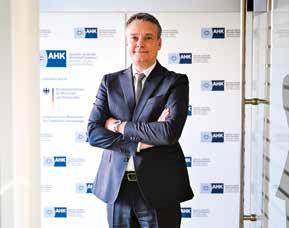
A recent survey by the German-Serbian Chamber of Commerce shows 88% of German firms would choose Serbia again as an investment destination. The result marks a rise in confidence compared to previous years, reflecting improved logistics and regulatory reforms. Serbia’s skilled workforce and cost advantages continue to attract new investment from German companies.
Leoni, a German automotive wiring systems manufacturer, has announced it will close its plant in Malošište, Serbia by the end of the year. The shutdown will lead to around 1,900 job losses. The reason cited is unprofitability, especially as the plant relies heavily on manual labour and is vulnerable to cost pressures in the European automotive sector.


“Our common goal is to make Serbia a reliable partner and attractive destination for German companies“
Marko Čadež

German car-parts manufacturer PWO Group is investing €28 million in a new factory in Čačak, Serbia. The plant will employ more than 500 people in its first phase, with capacity expected to reach 800 jobs. Production will focus on components for electric vehicles, safety systems, and comfort features, using energy-efficient processes.

Serbia recorded a trade surplus with Germany in 2024 — the first time in twenty years. Exports to Germany reached €4.6 billion, while imports stood at €4.4 billion. The shift reflects growing competitiveness of Serbia’s industrial and export sectors, and signals deeper integration into German and broader EU supply chains.

oltage surges can result from both direct and indirect lightning strikes, as well as from switching operations within power networks. Surge protection therefore safeguards not only against lightning, but also against a wide range of power line disturbances.
VSurge protection equipment ensures that energised power lines are properly equipotentially bonded. It acts before the insulation in electrical and electronic devices can be irreparably damaged by surges.

As with power systems, telecommunications and data technology are highly sensitive to voltage surges. It is therefore essential to protect telecommunications infrastructure and data centres against overvoltage events.
For more than 50 years, OBO Bettermann has been developing surge protection systems for virtually every installation environment. Our spirit of innovation, technical expertise and global project experience is embedded in each solution.
As a comprehensive system provider, OBO offers a surge protection portfolio with components that operate seamlessly together. Buildings of all types, as well as systems with varied overvoltage protection requirements, are effectively safeguarded. OBO stands for proven brand quality, expertise and competitive pricing.
All OBO surge protection equipment is tested in accordance with international standards at our own BET Test Centre and comes with a five-year guarantee. Numerous national and international test marks, including VDE, UL, KEMA, ÖVE, EX and CCCR, attest to the quality of our products.
Sanjin Laganin General Manager, Dr. Oetker Serbia
Digitalisation today represents essential infrastructure without which there can be no business development. Yet, in my view, the most important result is the strengthening of organisational culture – we have built a more open, flexible and creative system in which every team member feels free to contribute and be part of the process of creation
n this interview for CorD, Sanjin Laganin, General Manager of Dr. Oetker Serbia, discusses the company’s key transformations – from innovation and digitalisation to the strengthening of organisational culture – and emphasises that creating a more open, flexible and creative way of working has been his team’s greatest achievement over the past three years.
IYou have been leading Dr. Oetker in Serbia for more than three years. Which result or change are you most proud of that best illustrates the company’s evolution under your leadership?
— Looking back, I am proud that we have further strengthened the company – through innovation, organisational culture and digitalisation. Innovation has enabled us to enrich our portfolio with products that fully meet the needs of the modern consumer, from quick and practical meal solutions to new flavours that bring inspiration into the kitchen. Digitalisation has significantly improved efficiency and speed. Yet, I believe the most important outcome is a stronger organisational culture – more open, flexible and creative – in which every team mem-

ber feels free to contribute and be part of the process. That transformation best illustrates the evolution of Dr. Oetker in Serbia.
The Dr. Oetker portfolio in Serbia today numbers more than 170 products, including locally developed innovations. What is your strategy for balancing German tradition with local creativity, and how important is it for Serbia to be a source of new ideas?
— For us, the brand’s tradition is a tremendous asset – built on consumer trust, product quality and consistent operations. At the same time, we believe the brand’s strength lies in its ability to adapt to local needs and inspire consumers with innovations creat-
ed here. For example, products such as Dr. Oetker Palenta “Quick & Easy”, High Protein oat porridges without added sugar, and chocolates developed in our market, were created by listening carefully to local habits and preferences. Patient market listening is a vital source of new ideas, providing insights into what consumers want today and may desire tomorrow. Such ideas often prove relevant across other markets as well. This balance of tradition and local creativity is what our consumers value most.
Organisational culture plays a decisive role in a company’s success. Over the past three years, how have you changed the way your team works – decision-making, product development – and which values have become the pillars of Dr. Oetker in Serbia?
— The business environment is changing rapidly, and companies must adapt. Digitalisation and the use of AI are reshaping operations, but successful change requires employees at all levels to be ready. We needed an organisational culture that recognises and fully supports transformation. We focused on three areas to strengthen our culture: leadership, innovation and communication. We worked with an external agency for two and a half years and have continued independently. Today, we are a company that embraces change and continues to grow.

Through clearly defined goals and tangible projects, dm builds a business model that links environmental responsibility, community well-being, and economic development
At a time when issues such as climate change and the preservation of natural resources are increasingly in the public spotlight, it is vital to take concrete steps. For years, dm drogerie markt has demonstrated a determination to make sustainability a strategic principle and part of everyday business practice.
The best proof of this is this year’s dm Group Sustainability Report, which covers results from 14 countries where the company operates. Among the priorities are the careful use of resources, reduced energy consumption and greater reliance on renewables, the protection of water resources, and the reduction of the CO2 footprint. In Serbia, these guidelines have been translated into a series of local initiatives and partnership projects, showing how sustainability can be built through joint action and the constant exchange of ideas.
“For us at dm, sustainability begins with everyday choices – from the products we offer and the way we operate, to the projects through which we support our community. Our goal is to inspire change that will have a long-term impact and to show that care for the environment and people can be part of everyday life,” said Svetlana Jovanović Mitić, Head of Marketing and Communications, dm Serbia and North Macedonia.
One of the most significant examples of a sustainable business policy is the {TOGETHER} competition for sustainable ideas, through which the company supported local community engagement. This year, dm backed seven projects within the competition, donating more than five million dinars.
From protecting the lesser kestrel – a globally endangered bird species – to mapping ragweed with the help of artificial intelligence, and
creating educational gardens and orchards of old varieties, the winning initiatives demonstrate the power that communities hold to drive change. A special value of the competition lies in involving young people and vulnerable groups, turning sustainability into a practice that empowers all members of society and leaves a lasting mark on the community.
dm’s sustainable approach is also evident in its product range. The company was among the pioneers in removing microplastics from
The goal is that by the end of 2025, as much as 90% of dm product packaging will be recyclable, while technological innovations, such as recycling CO2 from industrial gases into bioethanol, open the way to new solutions in production
its own-brand cosmetics – a practice it has maintained for more than ten years. The goal is that by the end of 2025, as much as 90% of dm product packaging will be recyclable, while technological innovations, such as recycling CO2 from industrial gases into bioethanol, open the way to new solutions in production.
On dm’s shelves, customers can find products carrying labels that confirm sustainable standards – from certified cotton and microplastic-free products to those bearing eco-labels such as the Blue Angel. In this way, sustainability is linked with everyday shopping, as choosing a responsible product becomes a choice for a healthier future. Customers thus become active participants in the chain of change, with sustainability finding its most important anchor in practice rather than in strategy alone. By combining international experience with local initiatives, dm confirms that sustainability is a long-term commitment and a community value, rather than just a passing trend. Whether reducing the ecological footprint, supporting green ideas, or carefully selecting its range, dm in Serbia and across the region demonstrates how responsible business can shape communities and inspire others to change.

“Economic cooperation builds bridges stronger than politics ever could“
Helmut Schmidt

A regional overview highlights Germany’s position as one of the largest foreign investors in the Adria Region. From automotive clusters in Croatia to logistics in Serbia and renewables in North Macedonia, German companies maintain a billion-euro presence. The trend underscores Berlin’s role as the economic anchor for Southeast Europe.

Germany’s trade volumes with Serbia and Croatia have now surpassed those with Russia. Analysts note the shift reflects both sanctions on Russia and the growing role of the Adria economies as near-shore partners for German industry. Automotive parts and energy projects lead the list of traded goods.

Slovenia has seen new commitments from German car-parts manufacturers seeking to strengthen supply chains within the EU. Production facilities near Maribor and Celje are being expanded to serve both Volkswagen and BMW. The investments reflect a strategy to keep critical components closer to home markets.

Henry Ford

Bosnia and Herzegovina is becoming a niche destination for German IT outsourcing. Several mid-sized German firms have opened service centres in Sarajevo and Banja Luka, citing cost efficiency and strong engineering talent. The projects create high-skill jobs and expand Bosnia’s integration into European tech networks.
Weishaupt doo Beograd
Omladinskih brigada 88 11070 Beograd


Marjan Vučak, President of the German-Croatian Chamber of Commerce, says Croatia is rapidly becoming a hub for German firms. Strong infrastructure, EU membership, and skilled labour have encouraged investment in IT, manufacturing, and green energy. Vučak stresses that German companies see Croatia as both a market and a regional gateway.

tel: +381 11 35 33 430
e-mail: info@weishaupt.rs www.weishaupt.rs


Gandijeva 115A,11070 Novi Beograd 063/328-315 - 060/345-6751- 060/345-6753 avukmir1@gmail.com www.vukmir.rs

Ljubica Barbulj CEO, Enetel
From a domestic software company, we have grown into an SAP Gold Partner and system partner with more than 70 completed projects. Today we employ over 150 people, operate in eight countries and are recognised as a trusted partner of global leaders
On the occasion of marking 15 years of Enetel Solutions, we spoke with Ljubica Barbulj about the company’s journey from a domestic software firm to a regional leader in digital transformation, about its most significant projects and international recognition, as well as its vision for development in the era of cloud technologies and artificial intelligence.
Enetel Solutions is celebrating 15 years of operations. How would you describe the company’s path from its foundation to today’s position as one of the leading partners in digital transformation?
— Our journey is best reflected in our philosophy – “Shaping the Future Together”. From a domestic software company, we have grown into an SAP Gold Partner and system partner with more than 70 completed projects. Today we employ over 150 people, operate in eight countries and are recognised as a trusted partner of global leaders. Alongside SAP implementations, we have also developed our own digital solutions –EMIS for energy efficiency in railway transport, AVIS for passenger information systems and Impoqo for e-commerce. Guided by expertise, partnership and a commitment to results, we have positioned ourselves as one of the main players in digital transformation and as creators of strategically important innovations.
You recently acted as a platinum sponsor of the SAP Business Suite Innovation Day event. What did this regional gathering mean for Enetel and what message did you wish to convey to partners and the market?
— For us, platinum sponsorship was much more than support for the event – it con-

At the SAP Partner CEE Kickoff we won Top Cloud Performer (3rd place) and a nomination for Most Strategic Cloud Deal, in competition with more than 1,200 partners
firmed our role in the SAP community and gave us the opportunity to present transformative projects that are setting new standards in the region. The event brought together leading IT and business executives and provided a valuable opportunity to share experiences and highlight innovations that are changing the way business is done. Our message was clear: Enetel Solutions is a reliable partner for companies seeking to ad-
vance their operations through state-of-theart SAP and cloud solutions.
The migration of Telekom Serbia’s SAP system to SAP Private Cloud – the largest such project in the Balkans. How is this endeavour changing the way companies in the region can use SAP technologies and develop their business?
— The migration of Telekom Serbia’s SAP system to SAP Private Cloud set new standards –both technical and strategic. Within a record timeframe of five months, we successfully migrated four SAP systems, with downtime reduced to just 33 hours, which is far below industry standards. This proved that domestic teams are capable of delivering projects of the highest complexity and importance. The project is also the largest SAP Cloud contract in the Balkans, making Telekom Serbia a pioneer and Enetel Solutions a strategic partner that is setting new benchmarks. The success has also been recognised internationally – at the SAP Partner CEE Kickoff we won Top Cloud Performer (3rd place) and a nomination for Most Strategic Cloud Deal, in competition with more than 1,200 partners.
How do you see the future development of Enetel Solutions – which trends in digitalisation and cloud technologies do you consider crucial for the coming period and how are you preparing to follow them?
— The future of digital transformation rests on a cloud-first approach, artificial intelligence and hyper-automation. Our task is to keep pace through constant investment in knowledge and innovation, and our mission is to remain a driver of change and a partner to clients in achieving agility, efficiency and sustainable growth.

Hansgrohe Group
Valjevo, September 2025. The Hansgrohe Group, a Germany-based market leader in innovation, design and quality in the bath and kitchen industry, has invested €85 million in building a factory in the city of Valjevo, where fittings have been manufactured since mid-2023.
“With this investment, we are strengthening our manufacturing network in Europe,” said Hans Jürgen Kalmbach, Chairman of the Executive Board of Hansgrohe SE. “The factory is part of our global manufacturing strategy to keep supply chains and transport routes short and safe.”
Hansgrohe relies on a high level of inhouse manufacturing expertise for its products. “With our employees at all locations, we fulfil our high-quality promise and thus ensure the satisfaction of our customers,” noted Kalmbach. “The factory in Serbia further strengthens our faucets competency. Now we have additional capacity, especially for the European market, to be close to our customers.”
“We have looked at locations around the world,” added Frank Semling, Hansgrohe’s Chief Operations Officer. “Valjevo offers us the best overall package. This includes both the availability of skilled workers and suppliers. In addition, Serbia has an association agreement with the European Union, which means that internationally high standards apply to investments such as ours. At the same time, the infrastructure is convincing. From the Serbian factory, we can meet the growing demand for our products in Europe more effectively and efficiently.”
Around 300 employees currently work for Hansgrohe in Valjevo, with plans to create up to 1,000 jobs in the long term.
The Hansgrohe factory in the municipality of Valjevo, about 100 kilometres southwest of Belgrade, is the most sustainable site within the Hansgrohe Group. A photovoltaic system on the roof, a combined heat and power plant to generate electricity, greywater use for toilets, 26-centimetre-thick roof insulation and triple glazing on the windows are just a few

examples of what makes the building and its operation sustainable. For this, Hansgrohe received LEED certification (Leadership in Energy and Environmental Design), an internationally recognised certification system for ecological building.
Since commissioning two years ago, brass production has been fully operational, with electroplating also launched in autumn 2024. With the Hansgrohe Group’s plans to make its production plants even more efficient and stabilise processes in Serbia, additional lines from the plant in Offenburg, Germany, will be added in 2025.
Hansgrohe is actively seeking cooperation with local partners, suppliers and new employees. Ana Živković, Commercial Director of Hansgrohe Serbia, emphasised: “To achieve our growth targets, we need the support of local partners, suppliers and employees. We are actively seeking suppliers for metal and plastic parts, as well as logistics partners, to join us in our mission to create one of the world’s best faucet factories. We are also on the lookout for highly motivated engineers and technicians who are passionate about excellence and innovation. Our focus is on sustainability and water-saving technologies, ensuring that our products meet the highest standards of quality. Join us in our commitment to delivering exceptional products to our customers.”
Knut Fleckenstein Chairman of the Board of Arbeiter Samariter Bund Deutschland
In Serbia and across the Western Balkans, Arbeiter Samariter Bund has grown from delivering emergency relief to becoming a long-term partner for social inclusion, housing, and resilience. With EU and German support, ASB continues to bridge urgent needs with sustainable development
We spoke with Knut Fleckenstein, Chairman of the Board of Arbeiter Samariter Bund Deutschland, about ASB’s 25 years of work in Serbia, its role in supporting vulnerable communities, and the organisation’s vision for strengthening resilience and inclusion in the years ahead.
ASB has been present in Serbia since 1999, with the support of the EU, the German Government and private donors, making a significant contribution in areas such as social inclusion, emergency relief and support for marginalised communities. How do you see ASB’s role today in Serbia’s transitional society, and

which areas do you plan to prioritise in the coming years?
— Since 1992, ASB South East Europe (ASB SEE) has implemented nearly 400 projects across seven countries of the Western Balkans, standing alongside those in need – rebuilding homes, providing economic opportunities, and enabling families to reintegrate or return to their places of origin with dignity. Since 1999, ASB SEE has grown from providing emergency relief to becoming a long-term partner in Serbia’s and the region’s transition, implementing projects worth nearly €200 million with funds from the European Union, the German Government, ADH and private donations. In Serbia, around 80,000 people have been assisted in 80 municipalities through more than 50 projects. ASB in Serbia has focused on providing durable housing solutions for vulnerable groups and refugees, both by supporting their integration in Serbia and their return to their places of origin. To date, through measures aimed at
economic sustainability, ASB has reconstructed or built nearly 1,200 houses and supported more than 600 families through business start-up programmes.
Today, our role is to bridge urgent needs and sustainable development – linking local communities with institutions, civil society with donors, and humanitarian responses with long-term solutions. In the coming years, our focus will remain on strengthening social protection and inclusion, empowering vulnerable groups through housing, training and livelihoods, and building the capacity of local communities to deliver resilient services. We will also prioritise advocacy, partnerships and policy dialogue, ensuring our work reflects local realities while contributing to Serbia’s broader EU integration path.
The United Against Domestic Violence project in the Western Balkans, funded by the German Federal Foreign Office, illustrates how cooperation between ASB
SEE and the German Government can concretely improve social services at the local level. How do you assess the impact of such projects – and are there plans to expand or replicate similar initiatives in other municipalities or regions?
— This project shows how targeted cooperation can bring real change. It has strengthened coordination between local governments, social workers and health providers, improved living conditions and services in 11 shelters across the Western Balkans, and raised awareness at the community level. The results are clear: more effective local responses, stronger institutions, and safer living spaces for victims of domestic violence. At the same time, it created a unified regional network of social workers committed to improving shelter accessibility, enhancing caregiver support, and promoting preventive measures against domestic violence.
A highlight was the regional conference in Skopje, which brought together practitioners, policymakers and civil society from across the Western Balkans. It showcased successful approaches, encouraged dialogue, and laid the foundation for stronger regional collaboration.
We are aware that efforts to combat domestic violence and femicide still require legal reforms, better data collection and stronger institutional frameworks. Yet, this project has set a milestone and created space for future regional initiatives. Building on this foundation, ASB SEE plans to extend similar models to additional municipalities in the Western
Balkans, while integrating digital tools, rural outreach and policy advocacy to ensure sustainable impact.
The ASB SEE initiative Social Dimension Initiative promotes regional cooperation in employment, social protection and the inclusion of people with disabilities. What have been the main obstacles to establishing effective coordination between local authorities, donors and civil society – and what, in your opinion, could help to overcome these barriers?
— The obstacles are well known: fragmented institutional mandates, inconsistent do-
With growing migration, demographic challenges and shifts in the labour market across the Western Balkans, how does ASB SEE – with the support of the German Government – plan to contribute not only to emergency responses, but also to the long-term resilience of local communities, through education, digital skills, inclusive policies and strengthened social cohesion?
— Emergencies will always require rapid action, but resilience is built in advance. Over the past decades, ASB has provided essential supplies such as food, medicine, clothing and blankets during earthquakes in Serbia and
Our role is to bridge urgent needs and sustainable development – linking communities with institutions, civil society with donors, and humanitarian responses with long-term solutions
nor priorities, limited administrative capacity and persistent stigma around disability and marginalisation. Overcoming them requires multi-stakeholder platforms at municipal and regional levels, stronger alignment between national strategies and donor agendas, and longer-term funding frameworks. Equally important is the role of the EU in investing in local capacities for inclusive planning and data systems, while promoting awareness that inclusion is not a cost but an investment in social and economic resilience.

Albania, as well as during floods in Serbia and Bosnia and Herzegovina. ASB has also delivered emergency equipment and established shelters for displaced people. This capacity to act with urgency and compassion has been recognised by donors, making ASB a reliable implementing partner in the Western Balkans for more than 30 years. However, resilience must extend beyond crisis response, and it can only happen if governments and local administrations are fully engaged – uniting our efforts, creating synergy and ensuring that local systems are prepared to sustain change. That is why ASB SEE works closely with public institutions to reinforce their role as the backbone of sustainable development. Together with the German Government, ASB SEE is committed to preparing people and systems for the future. This means expanding vocational and digital training, ensuring inclusive access to education and social protection, and supporting policies that leave no one behind. It also means fostering social cohesion by building trust between migrants, returnees and host communities. By strengthening municipal services, investing in preparedness and promoting regional cooperation, we help local communities face demographic and labour market changes with confidence, dignity and longterm resilience.
Exploring the pulse of the city’s art through spaces that inspire as much as the works they present
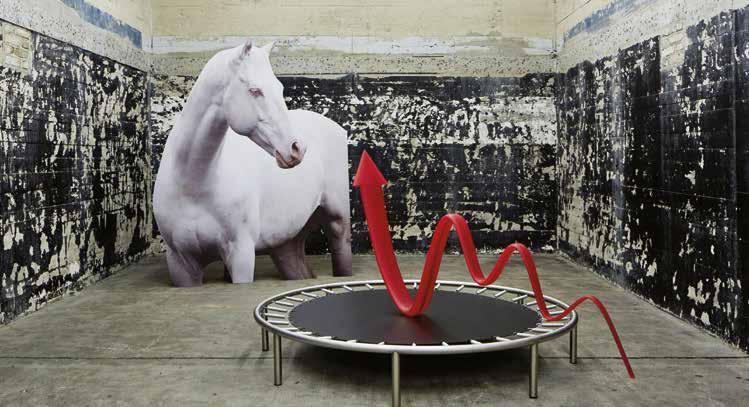
A former WWII bunker reborn as a private museum, the Boros Collection is one of Berlin’s most coveted art experiences – accessible only through pre-booked tours. Top Exhibit Rotating installations by international artists interact dramatically with the thick concrete walls and narrow corridors.
It transforms history into an avant-garde stage, where space itself becomes part of the exhibition.
Here, art feels unearthed – an archive carved into Berlin’s concrete heart

Designed by Mies van der Rohe, this glass-and-steel icon houses masterpieces of modernism and bold contemporary interventions.
The current Lygia Clark retrospective, alongside Fujiko Nakaya’s fog sculpture in the sculpture garden, merges classic modernism with immersive experience.
It’s where Berlin’s architectural modernism meets today’s artistic experimentation.

Spotlight Venue
A deconsecrated Brutalist church, now a gallery with soaring volumes that give monumental presence to contemporary works.
Top Exhibit
Large-scale solo shows, ranging from sculpture to conceptual installations, each adapted to the cathedral-like space.
Why It Matters
The venue itself becomes part of the artistic dialogue – raw concrete, silence and scale.
A sacred space where faith is replaced by art
Berlin’s main contemporary art museum, located in a former railway station, offering vast halls for blockbuster exhibitions.
Delcy Morelos’s immersive Madre installation and Petrit Halilaj’s An Opera Out of Time anchor the current season.
It sets the international pace of Berlin’s art scene, bridging past and present.
The city’s cultural locomotive – always on the move, always surprising


“Business opportunities are like buses; there’s always another one coming”
Richard Branson

Singapore’s Carro, Southeast Asia’s largest used-car platform, is preparing to expand into Australia while pursuing a dual listing in Singapore, Hong Kong, or the U.S. The company, valued at more than \$3 billion, is also eyeing new acquisitions to accelerate growth. Backed by Temasek and SoftBank, Carro is investing heavily in AI to streamline its operations. A successful IPO would put the company among the region’s leading tech champions. For global investors, it signals that Southeast Asia’s digital economy is maturing fast.
Nvidia has taken a \$5 billion stake in Intel, forging an unlikely alliance between two long-time chip rivals. The deal is aimed at shoring up Intel’s lagging position in the AI and data-centre markets, while strengthening U.S. domestic chip capacity. Intel has been struggling with losses and delays, while Nvidia dominates the AI hardware boom. Analysts say the move reflects a wider strategy to reduce reliance on Asian manufacturing and secure supply chains. It’s a marriage of necessity in an industry that shapes the future of technology.


Abu Dhabi’s ADNOC and partner Carlyle have abandoned their planned \$30 billion takeover of Australia’s Santos. After months of talks, the consortium concluded that regulatory hurdles and political resistance made the deal too risky. The collapse sent Santos shares tumbling and sparked debate over the future of foreign investment in Australia’s energy sector. Analysts also warn that valuation disputes highlight uncertainty in global oil and gas markets. For ADNOC, it’s a rare retreat in its global expansion drive.

Albert Einstein

Indian steelmaker Jindal has made a non-binding offer for Thyssenkrupp Steel Europe. The proposal includes investment in green steel and a pledge to maintain production in Germany. Thyssenkrupp’s share price jumped as the bid was confirmed, but the government will weigh the impact on jobs and pensions.
Siemens, Volkswagen, SAP, Deutsche Bank and other top firms are preparing a €300 billion initiative to boost confidence in Germany’s economy. The joint effort aims to combine private capital with policy support through 2028. It reflects fears that Europe’s largest economy risks falling behind global competitors.


Dr. Jeannette Friedrich
Executive Director Group Steering & Sales, Messe München GmbH
Serbian companies are steadily increasing their visibility at Messe München’s world-leading trade fairs. With logistics, IT and sustainability at the forefront, new opportunities are opening for partnerships with German and European industries. Messe München positions itself as a catalyst for innovation, cooperation and international expansion
In conversation with CorD, Dr Jeannette Friedrich, Executive Director Group Steering & Sales at Messe München, highlights Serbia’s growing role as a regional hub. She notes that local companies, from logistics and environmental technologies to IT and digital solutions, are finding fresh opportunities to showcase expertise and establish strategic partnerships. With sustainability and digital transformation as central themes, Messe München provides Serbian businesses with direct access to global decision-makers and best practices.
Many Serbian companies regularly participate in trade fairs organised by Messe München, including transport logistic. How would you assess the contribution of Serbian exhibitors within the wider European – and particularly German –logistics and trade fair ecosystem? — Due to its geographic position, Serbia is regarded as a regional logistics hub in the Western Balkans, which makes it an attractive partner for European markets. The number of Serbian exhibitors at our leading trade fairs has risen steadily in recent years. This applies not only to transport logistic, but also to the environmental technology fair IFAT and the electronics fair electronica.
Our trade fairs provide Serbian companies with a platform to expand their business, enhance their visibility on the European market and establish new international partnerships. With a regional contact person on site, we offer targeted support in preparing and implementing their trade fair presence. This is particularly valuable for smaller companies, enabling them to

access the European market successfully –even with limited budgets.
With Serbia positioning itself as a regional logistics and industrial hub and implementing major infrastructure projects, in which areas do you see the greatest potential for strengthening German–Serbi-
an cooperation through Messe München’s trade fair platforms? Which key trends and innovations would you highlight as most relevant for Serbian companies seeking stronger visibility on the German and European markets?
— Serbian companies currently enjoy favourable opportunities to expand their pres-
ence on the German and European markets. In addition to the traditionally strong logistics industry, Serbia’s IT sector has developed significantly in recent years. A growing start-up scene and new approaches in areas such as artificial intelligence and blockchain make Serbia a relevant location for technological services in Southeast Europe. German SMEs, in particular, are increasingly seeking cost-efficient and highly qualified IT and development solutions. Serbian companies can meet this demand by positioning themselves as reliable partners for outsourcing and technological cooperation in the DACH region.
At the same time, the requirements of the logistics and transport sector are evolving rapidly. Digitalisation, AI-supported logistics solutions, sustainable transport and energy concepts – including alternative drive systems, CO2 reduction and green supply chains – as well as multimodal and air freight solutions are all gaining importance. Certifications are equally crucial, for example in relation to new EU regulations such as the CO2 border adjustment mechanism. Companies that embrace these trends early, cooperate with partners and demonstrate innovative pilot projects will secure a clear competitive advantage.
International visibility plays a decisive role in this process. Munich’s world-leading trade fairs – such as BAU, bauma, productronica, automatica and Expo Real – offer Serbian companies the opportunity to showcase their expertise directly to international decision-makers. Messe München is an obvious gateway to global markets for Ser-
bia. In addition to Germany, visitors come predominantly from neighbouring European countries, followed by China and the United States.
Digital resilience and the green transition are increasingly shaping industry priorities. How does Messe München encourage exhibitors to translate these themes into tangible products, services and business models, and how could this inspire companies from Serbia?
— We see ourselves as an innovation platform that brings together expertise from across the globe in one place. Sustainability and digital transformation are reflected in almost all of our trade fairs – whether
New free trade agreements ease market access, while there are no barriers such as visa restrictions or trade impediments
through conference programmes, curated special areas or guided tours. These formats showcase current trends, demonstrate practical applications and provide momentum for the further development of business strategies across key sectors and industries. Serbian companies can benefit by gaining insights into new technologies, exchanging experiences with international market leaders and accessing best practices for sus-
tainable business models. This creates valuable impetus for long-term competitiveness in European markets.
Trade fairs are powerful platforms for connecting markets, knowledge and innovation. Which messages from Messe München’s recent events would you single out as particularly important for fostering bilateral trade and technological cooperation between Germany and Serbia?
— Our events clearly demonstrate that international trade fairs are powerful drivers of bilateral trade and technological cooperation. For small and medium-sized enterprises in particular, they provide opportunities to establish direct contacts with decision-makers, learn about current industry trends and gain access to new markets.
Key trends such as digitalisation, AI and sustainability are ideally suited to German–Serbian economic cooperation and, combined with the initiatives of the German-Serbian Chamber of Commerce, provide concrete entry points for deeper cooperation at both strategic and operational levels.
Messe München regards itself as a platform for encounters and cooperation. We invite Serbian companies to actively use these opportunities to strengthen their position in Germany and Europe over the long term. The conditions are favourable: new free trade agreements ease market access, while there are no barriers such as visa restrictions or trade impediments. Germany has long been one of Serbia’s most important trading partners, and the German market remains crucial, especially for Serbian exports.
„Vaš partner za prevoz vangabaritnih i teških tereta”
“Your partner for transport of oversized and heavy cargo”
“Ihr Partner für Großraum- und Schwertransporte”
Holleman Transport d. o. o.
Milinka Kušica 1/3, 11250 Belgrade, Serbia
Phone: +381 11 257 1 389, E-mail: info@holleman.rs www.holleman.rs


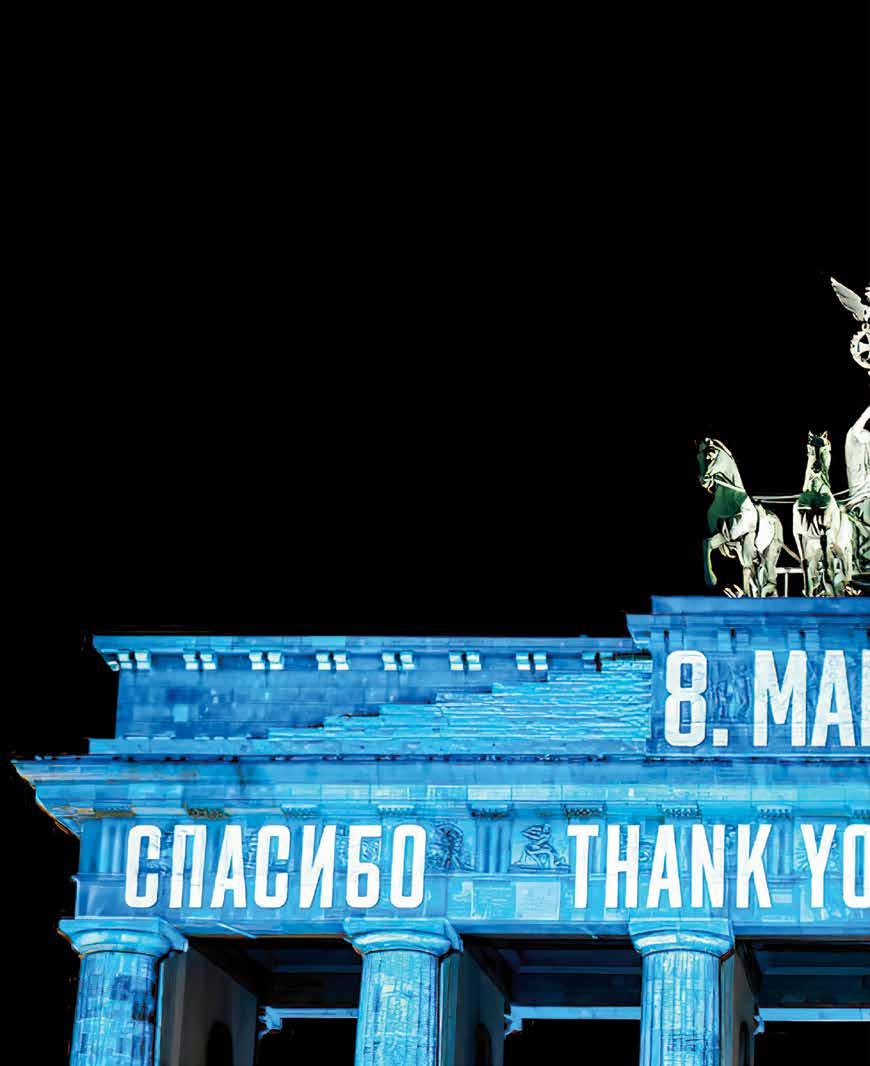
All German regimes since 1945 have faced the same dilemma, seeking to resolve it in accordance with their ideological tenets. The Christian Democratic governments of Konrad Adenauer, the first Chancellor of West Germany, consistently ignored the significance of 8th May, which was not commemorated.
Only with the change of government and the arrival of the Social Democrats in the late 1960s were the first, albeit timid, steps taken towards commemorating the end of the war
Germany’s capitulation in the Second World War was signed in the early hours of 8th May at the Soviet headquarters in the eastern part of Berlin. Due to the time difference between Berlin and Moscow, the Soviet Union celebrated 9th May as “Victory Day”. Thus, Russia, like much of the world, marks the end of the Second World War on 9th May. Although this difference may seem trivial, in contemporary Germany the choice of whether to commemorate on 8th or 9th May carries a clear political message. This year’s eightieth anniversary of the end of the Second World War in Germany, as well as
globally, undoubtedly unfolded under the shadow of the conflict in Ukraine. The traditional Victory Parade on Moscow’s Red Square attracted far fewer international guests than in previous years. At the same time, the Berlin Senate decided that in 2025 no delegations from the former Soviet republics would attend ceremonies dedicated to the end of the war. For the first time, the descendants of Red Army soldiers did not participate in marking their ancestors’ victory. President Frank-Walter Steinmeier and newly elected Chancellor Friedrich Merz, together with other German leaders, laid wreaths before the statue by renowned German artist Käthe Kollwitz dedicated to the civilian victims of war and violence. This striking depiction of a woman in agony cradling a dead child was not chosen by chance, but deliberately after reunification as a symbol of the commemorative practice of a unified Germany. Installed in the Neue Wache on Unter den Linden, a neoclassical building erected in 1818 to mark

the Prussian victory over Napoleon, it transformed what was once a symbol of Prussia’s militaristic spirit – later inherited and reinterpreted by Nazi Germany – into the central site for commemorating the end of the Second World War.
Nevertheless, German society lacks a clear consensus on how to remember the day the German army capitulated at the Soviet headquarters on 8th May 1945. The question is far from unambiguous. It is intertwined with the contradictions of Germany as a state, but also with deeper universal and national questions. Can one celebrate the defeat of an army in which one’s forebears fought, regardless of its methods, ideology, or crimes? Millions of Germans fought for six years in Wehrmacht units. For much of the public, their engagement is seen as separate from the crimes of the Nazi regime. Although the myth of a “clean Wehrmacht” was undermined by serious research, public lectures, and exhibitions after 1990, it has not been fully erased from collective memory.

On one hand, the defeat of the Wehrmacht led to the collapse of a regime that inflicted lasting damage on Germany’s reputation and traditions. At the same time, many German citizens under such a system were second-class citizens, political prisoners and pariahs. For that reason, 8th/9th May undoubtedly represented liberation from a deeply repressive regime. Yet, on the other hand, the German nation had never been in a worse situation than at the end of the Second World War. Millions of Germans were forced to leave their homes in neighbouring countries, and Germany’s territory was significantly reduced. Refugees returning to Germany encountered hunger, poverty and ruined cities. Bearing this in mind, both the political leadership and the people as a whole were torn between the need to demonstrate support for the Allied victory and the collapse of Nazism, and the need to acknowledge the national tragedy that the Second World War so clearly represented.
All German regimes since 1945 have faced the same dilemma, seeking to resolve it in accordance with their ideological tenets. The Christian Democratic governments of Konrad Adenauer, the first Chancellor of West Germany, consistently ignored the significance of 8th May, which was not commem-
German society lacks a clear consensus on how to remember the day the German army capitulated at the Soviet headquarters on 8th May 1945. The question is far from unambiguous
orated. Only with the change of government and the arrival of the Social Democrats in the late 1960s were the first, albeit timid, steps taken towards commemorating the end of the war. On the twenty-fifth anniversary of
Germany’s capitulation in 1970, Willy Brandt’s government declared 8th May as the day when Nazi tyranny was defeated. The Christian Democratic opposition harshly criticised the government, declaring that “defeats are not celebrated”. When they returned to power in the early 1980s, the debate reignited. Chancellor Helmut Kohl carefully sought, together with other world leaders, to pay tribute also to German soldiers who had fallen during the war. Particularly controversial was his 1985 visit with U.S. President Ronald Reagan to the Bitburg military cemetery, where not only Wehrmacht soldiers but also SS troops were buried.
On the other side of the Iron Curtain, in East Germany, the situation was far clearer. German communists had no doubt that it was a holiday to be celebrated. At the same time, it was an opportunity to express gratitude to Soviet soldiers and the Party leadership, and to demonstrate loyalty to
the ideals of the Soviet bloc. The official name of the holiday was “Day of Liberation of the German People from Hitler Fascism”. The central site of commemoration was Treptower Park in East Berlin, where the imposing Soviet monument to the liberator soldier, holding a child and sword while trampling a broken swastika, was located. Each year on 9th May, as celebrated in the Soviet model, delegations from various organisations laid wreaths to honour the 80,000 Soviet soldiers who died fighting for Berlin.
After reunification in 1990, these two impulses had to be reconciled. A compromise was reached: the day would be marked, though not ignored, but commemorated on 8th May and far from Treptower Park and its Soviet statues. Instead of a victory celebration and vows of eternal readiness to fight fascism, German leaders chose to honour all victims of war and violence, thereby not limiting themselves to the victims of the Nazi regime. Ten years after reunification, Chancellor Gerhard Schröder declared: “Nobody today disputes that 8th May 1945 was a day of liberation from National Socialist rule, genocide and the horrors of war.”
This, however, does not mean that everyone is satisfied with the way the end of the conflict is marked. In late April and early May, Berlin is
often covered with posters calling for the celebration of 9th May under the provocative slogan “Whoever doesn’t celebrate has lost!”. The organiser is usually Antifascist Action (Antifa), a highly heterogeneous umbrella organisation of the far left. Its roots lie in interwar Germany, founded in 1932 as the militant wing of the Communist Party of Germany to fight the Nazis. Modern Antifa is far more ideologically diverse than its predecessor, from which it inherited aesthetics and a tendency towards violent activism. Yet its proclaimed goal remains the same – to combat fascism everywhere and by all means. For its supporters, celebrating 9th May symbolises the complete rejection of Nazism and its legacy. Neither the date nor the site of this alternative commemoration – 9th May in Treptower Park – is accidental.
There are also those, such as the youth wing of the Green Party, who use the same slogan, “Whoever doesn’t celebrate has lost!”, to call for 8th May to be declared a national holiday of victory. These initiatives have yet to succeed. Nevertheless, certain federal states, mostly former East German territories (Mecklenburg-Vorpommern, Brandenburg, Thuringia and Saxony) and traditionally left-leaning regions in the west (Hamburg, Bremen and Schleswig-Holstein), have


established remembrance days for the end of the war and Germany’s liberation. In Berlin this year, a ceremony was held in front of the Brandenburg Gate, with the day declared a public holiday.
There are also those who hold a very different view. Each year, in the small town of Demmin in north-eastern Germany, right-wing extremists gather for a “March of Mourning”. In April 1945, as Soviet troops advanced and German forces retreated, hundreds
The dominant state narrative recognises the Allied victory and liberation from Nazism in principle, but stops short of openly celebrating it, instead directing focus on the victims of war and violence
of civilians (mainly women and children) committed suicide, fearing atrocities and revenge. Since 2007, rightwing groups have assembled here to mourn what they see as the victims of the German people, the fall of the Reich, the beginning of foreign occupation and “imposed guilt”.
Commemoration in Berlin: Federal President FrankWalter Steinmeier (centre), together with Bundestag President Julia Klöckner (CDU) and Federal Chancellor Friedrich Merz (CDU), lays a wreath at the Federal Republic of Germany’s central memorial to the victims of war and tyranny
Thus, it is clear that there is no complete consensus on how the end of the Second World War should be remembered in Germany. The dominant state narrative recognises the Allied victory and liberation from Nazism in principle, but stops short of openly celebrating it, instead directing focus on the victims of war and violence. A smaller yet influential school of thought calls for fully embracing Victory Day, celebrating and paying tribute to the Soviet soldiers who were instrumental in achieving it. Finally, a very marginal but persistent tendency exists, limited to farright circles, which mourns the end of the war and the Allied victory.
Dr Rastko Lompar Balkan Institute SASA

Michele Buck Former CEO of Hershey
After eight years at the helm, Michele Buck leaves Hershey stronger, saltier, and still sweet—proof that chocolate remains comfort, even as she built a snacks empire
Hershey Company in March 2017, she was stepping into history. Hershey, founded in 1894, had been led by many capable executives, but never by a woman. Buck’s appointment broke that barrier. Yet she was not a symbolic choice — she was a strategist with a clear mandate: to future-proof a company built on chocolate bars in a world where consumer habits were tilting toward all-day snacking.
Buck had already served as Hershey’s Chief Operating Officer and knew the company inside out. What she saw was a beloved American brand with an unparalleled emotional connection to consumers — but one that risked depending too heavily on a single product category. “Our full potential is to capture new consumers and as many snacking occasions as possible,” she told Fortune. That phrase, “as many snacking occasions as possible,” became the guiding principle of her leadership.
Diversification was not a new idea at Hershey, but under Buck it became a deliberate, disciplined strategy. Within her first year as CEO, Hershey acquired Amplify Snack Brands, owner of SkinnyPop popcorn, for $1.6 billion. More deals followed, including Pirate’s Booty and Dot’s Homestyle Pretzels, which together gave Hershey a foothold in the booming salty snacks category.
By 2024, snacks accounted for around 10% of Hershey’s $11.2 billion in sales. Buck openly wished the share was even larger, but she recognised the process had been one of learning as much as buying.

“Early on, our M&A capability was not where it needed to be and we stubbed our toe on a couple of small acquisitions,” she admitted. Those stumbles made Hershey sharper in evaluating future targets and more confident in integrating them.
The result was a company less dependent on the ups and downs of seasonal chocolate sales, better positioned to compete with rivals like Mondelez and PepsiCo, whose broad snack portfolios give them year-round relevance.
Still, Buck never let Hershey drift too far from its heritage. The company’s identity is inseparable from chocolate, and Buck understood its unique emotional resonance. “Our consumers tell us that chocolate pro-
vides emotional well-being, and we’ve seen especially recently as stress levels register higher, that chocolate plays an even bigger role in their lives,” she said.
That insight proved particularly important during the pandemic years, when sales of chocolate surged as consumers sought comfort. Even as she built Hershey into a diversified snacking company, Buck emphasised that the heart of its brand remained the familiar favourites: Hershey’s milk chocolate bars, Kit Kat, and Reese’s peanut butter cups — the latter being her personal favourite in its mini form.
Under her watch, Hershey invested in modernising its classic lines, introducing portion-controlled packs and new flavour variations to appeal to changing tastes without alienating loyal fans. She struck a delicate balance between innovation and tradition, ensuring that chocolate retained its role as both a nostalgic treat and a modern indulgence.
Buck’s leadership style has been widely noted for combining discipline with empathy. Having built her career at Kraft Foods and Nabisco before
The
company’s identity is inseparable from chocolate, and Buck understood its unique emotional resonance
joining Hershey, she brought operational rigour to the CEO role. Yet colleagues often highlighted her accessibility and the emphasis she placed on company culture.

She became a visible advocate for diversity in leadership, mentorship of younger executives, and creating a workplace environment where innovation could thrive. At Hershey, a company still deeply connected to the community of Hershey, Pennsylvania — home to its founder’s legacy and the Milton Hershey School for disadvantaged children — Buck framed corporate growth in terms of social responsibility as well as profit.
Hershey under her leadership also expanded its sustainability commitments, addressing issues such as responsible cocoa sourcing, reducing its environmental footprint, and supporting initiatives in the communities where it operates.
Her tenure was not without challenges. Rising commodity costs, global supply chain disruptions, and shifting consumer health preferences all tested
Hershey’s resilience. The push into salty snacks was in part a hedge against volatility in cocoa and sugar markets, but it also reflected Buck’s belief that Hershey could play on a much larger stage.
By broadening the company’s scope, she also broadened its risk profile, bring-
She struck a delicate balance between innovation and tradition, ensuring that chocolate retained its role as both a nostalgic treat and a modern indulgence
ing Hershey into more direct competition with food and beverage giants. Yet by the time she announced her decision to step down in 2025, the company was firmly established as a player in both indulgence and everyday snacking.
As Buck exits the corner office, Hershey is a stronger, more diversified company than the one she inherited. It has grown revenues, strengthened its M&A capabilities, and preserved the cultural meaning of chocolate in American life.
Her legacy is a business that is both sweet and salty, indulgent and resilient, rooted in tradition yet open to reinvention. In doing so, Michele Buck showed that the challenge of leading a heritage brand is not simply to protect it, but to reimagine it.
For the consumers who turn to Hershey chocolate for comfort — and for the investors looking for long-term growth — she leaves behind a company ready for its next chapter. The emotional pull of chocolate endures, but thanks to Buck, Hershey can also compete for the countless other snacking moments that define modern life.
Swimming and paragliding were moments of solitude, introspection and personal struggle. Sailing is a shared experience – something we build together. On the yacht I have found a way to be a father, a husband and a friend
Free time has never, for me, meant merely stopping work, but a space where I rediscover myself, explore new paths and find balance between what I do and who I am. Since childhood, I have enjoyed leisure, duties, study and sport – only in different measures. The way I spend my free time says more about me than anything else, and looking back I see a clear thread linking my hobbies. Each choice has been meaningful.
Swimming was my first serious passion, though it soon grew into a way of life – discipline that shaped me. I remember early mornings at the pool, the smell of chlorine, the silence before the first dive. Competitions taught me to deal with victory and defeat, to give everything in one moment, and to keep going regardless of the outcome. That discipline proved invaluable when I entered medicine and surgery.
When I started medical school, I gave up competitive swimming. It was not a hard decision – it came naturally. The pool had been my second home, but it was time to embrace books, lectures and endless practice. Yet in letting go I found a new freedom – to explore fresh interests and discover new hobbies. Medicine took one chapter, but opened new horizons. One of them was paragliding. I still recall how a family friend first described his flights, and soon I was airborne myself – from Zlatibor to Meljine. Silence in the sky, the sensation of floating, the view from above – it was almost meditative. Paragliding gave me freedom, unpredictability and exhilaration. Each take-off was a decision carrying risk; each flight

a new adventure. It balanced the rigid weekdays of exams and rules with the weekends in the mountains and the sky.
Later, as I specialised in vascular surgery, paragliding became too great a risk. Surgery requires knowledge, speed, difficult decisions, constant availability – and at the same time offers creativity, joy, triumphs
and defeats. To be stable, physically and mentally, I could not afford accidents. No matter how much I loved the sky, I could not give myself fully to both passions.
Then, in a casual talk with a fellow paraglider, we both mentioned sailing. Soon I was on a skipper’s course and found myself on the Aegean. This time, my family and friends were with me. Silence, the sound of waves, movement without an engine. Once again I read the wind and nature’s signs. Wind in the sails, water beneath, horizon ahead – it gave me the same mix of freedom and control, excitement and peace.
Sailing is different because it is not only my personal hobby, but also a
Surgery demands vast knowledge, quick thinking, difficult decisions and complete dedication, yet it also offers creativity, excitement, joy, fulfilment – and moments of loss and stress
shared space for my family and friends. Swimming and paragliding were solitary pursuits, but sailing is collective. On the yacht I found a way to be a father, husband and friend, while still remaining the boy who once sought freedom in sport. Swimming taught me discipline, paragliding freedom, and sailing – balance.
Across nearly half a century, my hobbies have changed with me. In them I found competition, freedom, adrenaline, stability, companionship, calm and beauty. They have mirrored my life stages as much as they have shaped me. Perhaps it is no accident that I have always sought water, air and wind. Free time, for me, has never been a luxury, but a necessity.

Gabriel Feltz (1971–2025) left us far too soon, yet his music and spirit will forever remain inscribed in the history of the Belgrade Philharmonic and the cultural life of Serbia. A German maestro who made Belgrade his second home, he gave the orchestra discipline and confidence, but above all joy, lifting it onto the world stage with unrepeatable energy and love
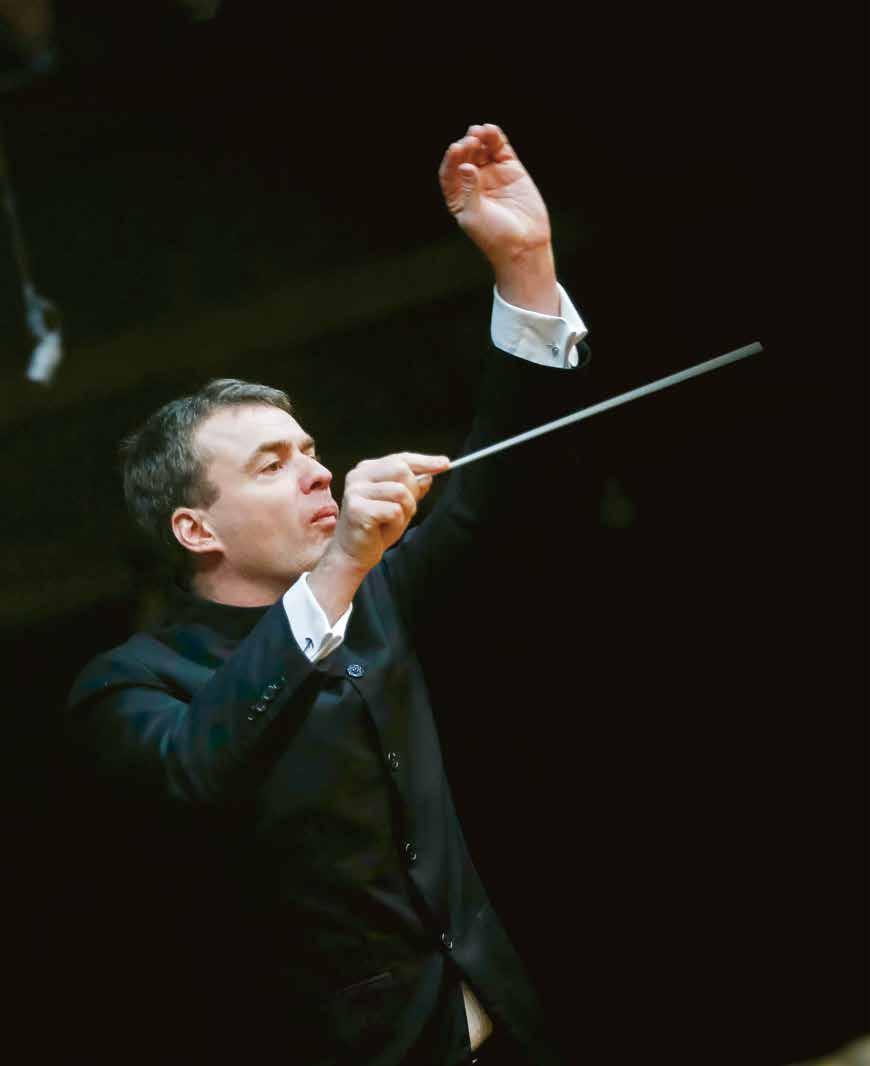

With profound sorrow, the Belgrade Philharmonic announced the sudden passing of its beloved Chief Conductor Gabriel Feltz, who died on 29th August 2025 in Essen at the age of 54. One of Germany’s most distinguished conductors, he built a versatile career across Altenburg-Gera, Stuttgart, Dortmund and Kiel before taking the helm of the Belgrade Philharmonic in 2017. From that moment, he became much more than a maestro: he was a friend, a leader, and a passionate advocate for the orchestra and for Serbian culture.
Feltz immediately began learning Serbian, capturing the hearts of the musicians, the audience and the wid-



er public. With tireless dedication he expanded the orchestra’s repertoire, raised its performance standards to international heights, and introduced bold undertakings – from marathon performances of Beethoven, Brahms and Mozart to the unforgettable Rachmaninoff Marathon of June 2025, which united the Dortmund and Belgrade Philharmonic Orchestras in what would prove to be his final artistic triumph.
On 18th September, the Belgrade Philharmonic offered a heroic farewell to its maestro at Kolarac Hall. In an unprecedented gesture, the orchestra performed Wagner’s Tristan Prelude and Beethoven’s Eroica without a conductor, guided only by the

by


In an unprecedented gesture, the orchestra performed Wagner’s Tristan Prelude and Beethoven’s Eroica without a conductor, guided only by the memory of his precise instructions and his indomitable spirit
memory of his precise instructions and his indomitable spirit. The famous “Tristan chord”, a symbol of eternal longing, resounded as a message of love, recalling the unforgettable full performance of Tristan und Isolde under his baton earlier this year. Beethoven’s Eroica, dedicated “to the memory of a great man”, carried the deepest symbolism of Feltz’s artistic path – from the energy of the opening movement, through the funeral march played in tears, to the glorious finale that revealed the orchestra’s unity and strength.
The standing ovations and prolonged applause that followed testified to the bond between Feltz, his musicians and their audience. A documentary film by Milan Škundrić shown between the works captured the profound connection he forged with Belgrade and Serbian culture.
With Gabriel Feltz, the Belgrade Philharmonic entered a new era, joining the ranks of Europe’s leading orchestras. He gave the musicians the courage to dream and the power to achieve, turning discipline into joy and music into shared celebration. Though his departure leaves an immense void, his legacy is eternal – in every note, every triumph, and every memory of a conductor who became one of us.

Selman Trtovac (1970, Zadar) is among the artists who’ve been shaped equally by their experiences of the Belgrade Academy and the German school of contemporary art. After two years studying painting at the Belgrade Faculty of Fine Arts, he continued his education in Dusseldorf, in the class of Klaus Rinke, where he was proclaimed a master student in 1997. His work combines the discipline and academic approach of his home school with the openness and conceptual explorations that marked the German art scene.
Trtovac is a curator and creator of numerous projects that have enriched Belgrade’s artistic life – from the Art Centre of the Svetozar Mark-

As a young man during the time of the country’s collapse, I had no power to confront the unfolding catastrophe other than artistic expression. After the war, I returned to Belgrade believing (and I still believe today) that it is precisely here, in a space that seeks confrontation and healing, that art is most essential. And that I can contribute to that as an artist


ović University Library, via the Third Belgrade art group, to the Goethe-Institut’s Menjačnica Gallery. More recently (2021) he was the co-curator (alongside Dr Ivana Bašičević Antić) of the exhibition “Those Who Do Not Want to Think Should be Thrown Out! Joseph Beuys and Mangelos - 100 years and art today”, with which they marked the centenaries of two great men in Belgrade: German artist Joseph Beuys and Dimitrije Bašičević Mangelos, both of whom were conceptual art pioneers in this region. Apart from curation and teaching work, Trtovac also deals with issues of spirituality, the meaning of existence and the artist’s role in a world marked by crises, fears and migrations. His works are held in numerous private and public collections, while his voice is among the few that combine experience of international circles of artists and engagement on the domestic cultural scene.
Which childhood or early life event do you consider as being crucial to you becoming an artist – when did you realise your life calling was art? — My awareness that art was my life calling began forming in secondary school, but it’s clear from today’s perspective that this was the result of a lengthy accumulation of experiences from early childhood. I wasn’t able to articulate it precisely back then, but I now recognise what led me intuitively to art. I was fascinated as a child by images, colours, shapes — the ways the world can be expressed visually. That fascination wasn’t merely aesthetic, but rather deeply existential. It
was while in secondary school that I first felt that art isn’t just an interest, but rather a way of thinking, being and communicating with the world. It was then that I realised art isn’t my choice — it is my calling, my mission. I today believe that inherited experiences of previous generations also influenced my path as an artist. Topics and feelings that remained insufficiently articulated in the family and social context gradually took shape through my work.
Art enabled me to observe them, to reshape them into a visual language
Stimulated drawing performance
Belgrade gave me the tools and Dusseldorf liberated me – encouraged me to seek my own path, to perceive art not as mere expression, but as a space of thought, resistance and exploration

and thus establish a connection with past generations, but also with those yet to come. My artistic work thus becomes a space in which the personal and the collective intertwine. I cannot know whether what I’m doing will have significance for the people who are yet to come, but I feel a responsibility to try.
You were born in Zadar, studied in Belgrade, and completed your education in Dusseldorf. How do you see your personal and artistic “journey” between these places and cultures? How did relocating from Belgrade to Dusseldorf change your artistic outlook, and what did you learn there that you wouldn’t have if you’d stayed? — My personal and artistic journey is deeply rooted in my complex identity, but also in the drama of the disintegration of the country of my birth. That journey wasn’t only geographical – from Zadar, via Belgrade, to Dusseldorf – but also spiritual, cultural and artistic. Relocating from Belgrade to Dusseldorf was a landmark event in my development. It opened the door to a different artistic discourse and to new ways of thinking and creating. I learnt in Germany that art doesn’t have to be merely aesthetic expression – it can and often must be a political act, a philosophical reflection and a social commentary. It was there that I realised an artist isn’t just a craftsman, but someone who enters the space of the unknown thought – a space in which art becomes a means of seeking truth in the modern world.
That experience enabled me to redefine my relationship with art, but also with the Balkans. Not out of nostalgia for Yugoslavia, but out of the need for dialogue, understanding and catharsis. As a young man during the time of the country’s collapse, I had no power other than that of artistic expression to confront the unfolding catastrophe. I returned to Belgrade after the war believing (and I still believe) that it is here, in this space that seeks confrontation and healing, that art is most essential. And that I can contribute to that as an artist.
The influence of Klaus Rinke can be felt in your work, but also your experience of the Belgrade Academy. How do you balance these influences, between tradition and modern experiments?
— Formative years shape one’s value system decisively – both in life and art. The influences I took from the Belgrade Academy, but also from my work with Klaus Rinke and Jannis Kounellis, were like the initial capsules for processes that developed later. Through years of hard work, I constructed my own expression, a characteristic stance and visual language that I consider authentic. I balance tradition and contemporary artistic experiments not by rejecting one in favour of the other, but by integrating them into my work process and frame of mind. That dialogue between heritage and modernity leads me to new insights. The Belgrade Academy gave me solid foundations – an insistence on sketching, the precision of the

Deus
A
craft and classical values of visual expression. In contrast, at the Dusseldorf Academy I was exposed to artistic practices that shaped German conceptual art and the Fluxus group – with artists who had a radically sociopolitical attitude that was often anarchist and utopian. I didn’t see a conflict in that contrast, but rather a space of liberation. Belgrade gave
Belgrade’s art scene is lively and dynamic, but it isn’t easy to work within that context.
Artists here are constantly confronted by existential fears

me the tools and Dusseldorf liberated me – encouraged me to seek my own path, to perceive art not as mere expression, but as a space of thought, resistance and exploration.
As initiator and editor of the fine art programme of the Art Centre of Svetozar Marković University Library, what kind of space did you want to create for artists and the public? You were later also the initiator and co-founder of the Third Belgrade group and the Goethe-Institut’s Menjačnica Gallery. What motivated you to initiate new spaces of artistic dialogue?
— The idea of the Art Centre was to create a space where students, post-graduates and young artists can work, experiment and discuss – a place open to exchanges of ideas, contrasting views and freedom of expression. It seemed to me that the university library was the ideal environment for such a dialogue. I had realised already during the time of my studies that the milieu wasn’t favourable to contemporary art – which is often perceived as superfluous or even problematic, as it cannot be easily controlled. Politics and business support it only
when it suits them, so artists often have to create spaces of freedom for themselves. Third Belgrade was my attempt to create a mini artistic utopia – a place where art isn’t only exhibited, but where space can be created for experimentation, freedom and togetherness.
The Menjačnica Gallery within the scope of the Goethe-Institut has a different function: it is a place for meetings and exchanges that forms part of Germany’s open cultural policy, which suits my own values.
I view my role in all of this as part of my own artistic work, in the Beuysian sense – as sculpting society through art.
Art here arises from a real need, from the feeling that it’s the only way to respond to the times in which we live. And no matter how hard it is, I find solace in the thought that art has survived much worse disasters - and that it will continue to exist in spite of everything.
You recently curated an exhibition dedicated to Joseph Beuys and Mangelos. What did it mean to you to link one of Germany’s most important artists with one of our region’s pioneers of conceptual art?
— That exhibition, which I conceived together with Dr Ivana Bašičević, was

How do you perceive Belgrade’s art scene today — what are its advantages, and what are the obstacles for artists?
— Belgrade’s art scene is lively and dynamic, but it isn’t easy to work within that context. Artists here are constantly confronted by existential fears – that is part of daily life, unfortunately. Institutional support is lacking and art is often perceived as a threat to certain political regimes. However, it is precisely this insecurity and constant struggle that creates a strong need for expression. The harder life is, the stronger the desire to live and create. That paradox gives this scene a special energy and intensity.
Existential themes are unavoidable if you’re serious about art, and symbols have always been a way for me to express what cannot be said directly – I use them to convey insights that are personal, but also universal
a kind of dialogue between two worlds — the German and the Yugoslav, between Joseph Beuys and Dimitrije Bašičević Mangelos. Both were born in 1921 and their art shaped the contemporary artistic language of the
time in which they lived and the artistic context in which they worked. Linking the two of them was a question of continuity for me, but also of a comparative view of art as a universal language. Their work is very important to the generations of artists living and working today.
Beuys insisted on the notion that “everyone can be an artist”. How important is that message when it comes to understanding art’s role in society today?
— For me, Beuys’s famous line “Every man is an artist” has a much deeper than that which is usually understood by the title artist. In my opinion, he was referring to the creative potential that exists within every person, regardless of what they do for a living and the kind of activity they perform in the workplace. It is actually a philosophical and anthropological idea, not just an artistic attitude. Beuys spoke about art not being reserved only for galleries and studios, but rather that each of us can change the world around us through creativity – whether that relates to our everyday life, work or social engagement. Behind this idea is the notion of a utopian vision of improved social and economic relations. That message seems more important than ever today, when we face major global challenges, ecological crises and the question of man’s role on this planet.
My opinion is that art isn’t a privilege, but rather a need. It is a way for us to see the world differently, to develop empathy and create better, more humane relationships – both between people and in society as a whole. Art helps us to change and grow, both as individuals and as a community.
What kind of approach do you have to symbols and existential themes? Has your artistic language evolved over time, and, if so, how?
— Existential themes are unavoidable if you’re serious about art, and symbols have always been a way for me to express what cannot be said direct-
ly – I use them to convey insights that are personal, but also universal. The most beautiful thing is when someone recognises part of their own experience in my work.
My artistic language has changed over the years, such that it has become simpler and clearer. However, I’ve always been preoccupied with essential existential questions. Those questions interest me at a personal level, but even more so at a societal levelthrough relationships between people and the values we share or lose.
How do you adapt your work in the context of contemporary challenges (digitalisation, art market, globalism); do you stick with classic media or experiment with new ones?
— I believe an artist should utilise everything that’s available. For me, media and technology are just tools –what really matters is the idea I want to convey. I experiment with different media whenever that makes sense; sometimes it is a classical form, sometimes digital, sometimes a performance or happening, but everything is always secondary to the idea. Art must communicate, and the medium is just a channel for that communication.
As for the art market, I think it’s a necessary evil, something that demands caution. The market should be approached strategically – an artist shouldn’t adapt their work to market demands. Marketing strategies must be harmonised with an artist’s personal rhythm and themes, and never the other way around. Art otherwise loses its meaning and becomes just another product, and that was never my goal.
You address spirituality and the meaning of existence. What is the artist’s role in a world marked by crises, fears and conflicts? How much has your personal and artistic identity been shaped by extreme circumstances like war, crises and uncertainty?
— I think the role of the artist, particularly today, is to observe the world carefully, to exert efforts to understand it
and to authentically convey to others what he sees and feels. In some ways, art – just like religion or science – can offer a healing perspective for this planet of ours. At the current level of technological development and production, wars, crises and poverty could be overcome easily. And yet the logic of profit and power still prevails, which seems absurd in the face of mortality.
My experiences of the crises of the ‘90s and fear certainly shaped me and my artistic identity. Such circumstances sharpen one’s view of reality and deepen the need to find truth through art. Art that’s created under extreme circumstances carries a special weight, but also a special responsibility. For me, this is a way to remain honest with myself and towards the times in which I live.
How do you view migration, both physical and mental? Are they a necessary part of the contemporary artistic experience?
— Since the emergence of humanity, people have moved, changed their surroundings and thus changed themselves and the societies in which they live. Physical migrations impact social relationships, while mental migrations change our inner worlds. My opinion is that they are both inevitable parts of the contemporary artistic experience. An artist must be open to both processes, because it is through them that we achieve transformation and new insights.
Migrations of people change established social patterns directly, forcing us to confront our own prejudices and often compelling us to change. When I say that, I’m primarily referring to “old Europe” and the legacy of the colonial way of thinking, which no longer functions.
Nation states are slowly losing their central role, as the very concept often leads to conflict. We are moving increasingly towards multinational, multifaith, polycentric and very complex social and economic relations. Art – if we understand it through Beuys’s extended notion of art – certainly plays a very important role in that process.
How do you view art’s role in a society that’s undergoing changes — should art be “critical”, provocative, or should it be more of a reflection of change than an active driver of it?
— Art can’t abide recipes – it has always been a surprise, something that eludes simple definitions. In my opinion, art must be complex: it should carry within it criticism, provocation, reflection, emotion and humour, but also a driving force. Art has some kind of “alchemical” character – it changes reality, transforms it into something new, often unexpected, but intimate. I don’t think people have to grasp every artis-
Nation states are slowly losing their central role, as the very concept often leads to conflict. We are moving increasingly towards multinational, multifaith, polycentric and very complex social and economic relations

tic message immediately, but it is important for it to move them, intrigue them, make them want to understand it. Art is thus simultaneously a reflection of reality and a catalyst for change – it can be both a reflection and a driver, but also a mental space in which personal and social growth are possible.
What would be your message to young artists and students – about art, life and the courage to think differently?
— Our great thinker, Miloš N. Đurić, said: “Follow your own spark and you won’t be mistaken”. That’s also the message I carry inside. Art demands courage, honesty and faith in one’s own spark. Everyone must find their own way, their own expression, their own truth. That’s the only way art can be authentic and can have power that benefits other people, that they recognise and that can potentially help them become better and more aware of processes that they might be going through themselves.
Two 84-year-old friends, Eleanor Hamby and Dr. Sandra Hazelip, have proven that wanderlust has no age limit. They set off to conquer all seven continents in just 80 days — and did it with style. From Antarctica’s icy plains to the streets of Cairo, their journey became a viral sensation. Their motto? “Don’t wait for adventure, chase it.” It’s the kind of story that makes everyone want to dust off a suitcase.

Jessica Nabongo, the first Black woman documented to visit every country in the world, is bringing her travels to the kitchen. Her upcoming cookbook, *Catch Me in the Kitchen*, promises a recipe from each of the 195 nations she explored. More than just food, it’s a celebration of cultures, people, and the stories that come with each dish. Nabongo has even settled down in Dakar, Senegal, turning her global life into a local one. It’s proof that food is the best passport.


Flying cars might still be a dream, but meet the airborne motorcycle — the Skyrider X6. This electric hybrid can roll down a street and then take off vertically, promising to change how cities think about mobility. It looks like something out of a sci-fi blockbuster, but prototypes are already grabbing attention. Tech enthusiasts say it could revolutionise short-haul travel. Imagine commuting above traffic, with the wind in your hair.
Forget foldable phones — August’s gadget buzz is all about rollable laptops. A new device stretches its display like a scroll, offering big-screen convenience that still fits in a backpack. Add in high-fidelity earbuds and a custom Switch-2 controller, and August was a good month for tech lovers. These gadgets aren’t just flashy, they’re practical game-changers. For once, the future feels portable.

August 2025 was a month of wild ideas in tech — and not all of them made sense. From AI “co-pilots” for daily life to space-Uber concepts, the line between genius and madness blurred. Investors are even throwing money at fusion startups with barely a blueprint. But chaos, some say, is where real innovation is born. It’s messy, unpredictable, and oddly exciting.


Science fiction is fast turning into medical fact. Researchers are making breakthroughs in 3D-printing skin, offering hope for burn victims and patients with severe injuries. The idea is to print living, functional tissue directly onto wounds. It’s experimental, but early results are promising. The day may come when doctors can literally “print a cure.”

Audi Q8 e-tron
Audi’s luxury electric SUV — spacious, refined, with serious range.
From timeless icons to cutting-edge electrics, German luxury cars continue to set the global standard for performance, innovation, and design.
Porsche Taycan Turbo S
Porsche’s electric sports car, blending performance with sustainable design.


Audi e-tron GT Sleek, performance-driven EV, sharing DNA with Porsche Taycan.
The timeless German icon — a nod to heritage and enduring design excellence.


The ultimate chauffeur car — luxury at its peak, with hand-crafted interiors.
Flagship all-electric luxury sedan, rival to Tesla Model S, but with classic Mercedes comfort.

The all-electric 7 Series — futuristic tech meets old-school luxury limousine.

BMW XM
A bold, high-performance hybrid SUV — controversial design, but a statement piece.

2 October – Sava Centre, Belgrade

Today, Ennio Morricone and Nino Rota are rightfully regarded as legends of world film music. This concert spectacle dedicated to their work will present the most important phases of the two composers’ careers, from the cult songs of the 1960s to scores written for Sergio Leone’s films and created for Hollywood. The new programme will allow the audience not only to hear live performances of works by these unparalleled masters, but also to experience a unique emotional journey through the waves of creativity of Rota and Morricone, where timeless themes intertwine with the inner world of artistic expression. The conceptual driving force behind the project is Marcello Rota, the world-renowned conductor. The film music will be performed by soloists who entered the history of Italian and global cinematography together with Ennio Morricone: Nello Salza (trumpet), Ludovico Fulci (piano) and Susanna Rigacci (soprano).
8 October – Serbian National Theatre, Novi Sad
International ballet stars Iana Salenko and Daniil Simkin will perform in Swan Lake on 8 October on the Jovan Đorđević Grand Stage of the Serbian National Theatre. This production of Swan Lake, choreographed by Vladimir Logunov, will be the first classical ballet with which the SNP Ballet opens its new season. Daniil Simkin is among the most renowned ballet dancers of our time, often compared to Mikhail Baryshnikov. He comes to Serbia to support the rejuvenated ensemble of the Serbian National Theatre Ballet, performing alongside his partner, the prima ballerina of the Berlin State Opera Ballet, Iana Salenko.

18 October – Kolarac, Belgrade

The Belgrade Music Festival (BEMUS) will present ten concerts from 16 to 25 October at Kolarac Endowment and other venues, with the main star being the celebrated violinist Maxim Vengerov. A favourite of the Belgrade audience and a Grammy Award winner, Vengerov will perform on 18 October together with pianist Polina Osetinskaya, once a child prodigy who, by the age of eleven, had already given a thousand orchestral and solo concerts. The programme includes Dmitri Shostakovich’s Sonata for Violin and Piano, Franz Schubert’s Sonatina in G minor, D.408, and Johannes Brahms’s Sonata No. 3 in D minor.
25 October -2 November - Belgrade Fair
The International Belgrade Book Fair is one of the oldest and the most important literary events in the region, with the main goal of helping publishers, authors, booksellers, librarians, book distributors, multimedia companies, and other people in the business establish contacts, exchange experiences, make business deals, and start other forms of business and cultural cooperation. All Serbian and the most prominent regional publishers choose to present their annual publishing work each year at the Fair. Book presentations are accompanied by numerous side events, such as conferences, round table discussions, guest author presentations, panel discussions, workshops, etc.



1 October – Grand Hall of the Serbian Academy of Sciences and Arts (SANU), Belgrade

Organised by the Serbian Academy of Sciences and Arts and the Heart Failure Society of Serbia, this symposium will present the results of a two-year study conducted by the European Society of Cardiology and SANU on the application of contemporary heart failure therapies in Central and Eastern Europe. The event will also highlight the achievements and future directions of SANU’s strategic project “Heart Failure is Defeatable –Evaluation of Treatment Quality in the Republic of Serbia (SpaS)”. Given the prevalence and high mortality of heart failure, these findings are of critical importance for public health. Live stream available: www.sanu.ac.rs/direktan-prenos
6-8 October – SASA Belgrade and Science & Technology Park, Novi Sad
The 23rd International Symposium on Power Electronics Ee2025 will be held in Novi Sad/Belgrade, Serbia, from October 8-10, 2025. The venue will be the Serbian Academy of Sciences and Arts, Belgrade, and Science & Technology Park, Novi Sad.

22 September – Gallery of Science and Technology, SASA Belgrade

Civilisation’s progress and the key events of human history have always been closely linked to the ways energy is obtained and used. Energy drives industrial production, powers transport of people and goods, fuels computers and enables communication devices. Experts estimate that by the mid-21st century four times more electrical energy will be consumed compared to all other non-electrical forms of energy combined. This points to the crucial role of power electronic devices that convert energy from one form to another, adapting it for transmission, distribution, storage and for use in households, factories and schools. The exhibition is authored by Academician Slobodan N. Vukosavić and Prof. Dr Vladimir A. Katić.
30 October – SASA, Musicology Institute, Belgrade
Held within the framework of the international conference “Symphonic Music after 1945”, this piano recital will be performed by Uki Ovaskainen.
Programme: Konjović, Rajičić, Ristić, Vasilije Mokranjac


4/9/2025
The National Alliance for Local Economic Development honoured female leadership and key contributors shaping Serbia’s business climate. Awards went to professionals whose achievements strengthen the economy and policymaking. Among the recipients were leaders from Philip Morris, Nestlé, Visa, MediGroup, APR, Coca-Cola HBC and others.



4/9/2025
The Embassy of Slovakia in Belgrade hosted a reception to celebrate Slovakia’s Constitution Day, gathering numerous representatives from Serbia’s political, cultural, and social life. In his address, Ambassador Michal Pavuk underlined the importance of 1 September 1992, the date when Slovakia’s Constitution was adopted as the foundation of the country’s statehood. Among the distinguished guests was Serbian Prime Minister Đuro Macut. The evening also featured an exhibition of artworks by painters from Kovačica, whose naïve art has been recognised by UNESCO as part of the world’s intangible cultural heritage.


10/9/2025
The International Women’s Club Belgrade opened its 2025/26 season with a Coffee Morning hosted at Etno Mreža’s showroom at the historic Zindan Gate, Kalemegdan. The gathering marked the start of preparations for the 22nd IWC Charity Bazaar, scheduled for December 7 at Belgrade’s Sava Centar. Members and guests enjoyed networking and cultural exchange while learning more about the upcoming event, one of the city’s largest multicultural charity initiatives supporting women’s empowerment projects across Serbia.


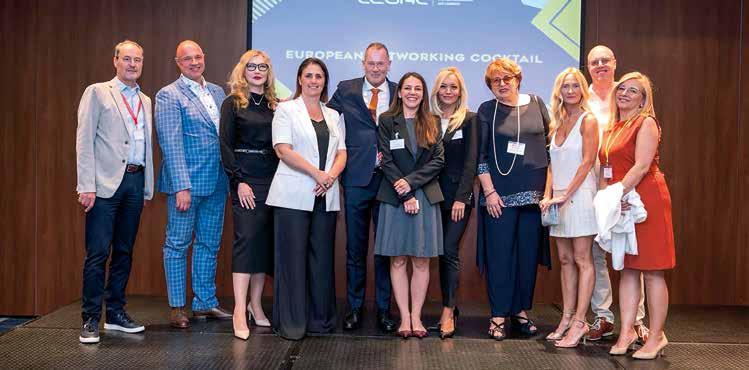
15/9/2025
At the Metropol Hotel in Belgrade, the Council of European Business Associations and Chambers in Serbia (CEBAC) hosted a networking cocktail that gathered leading diplomats and representatives of the European business community. The event brought together two ambassadors, representatives of economic departments from four embassies, as well as CEOs and board members of European business organisations active in Serbia. It served as a platform for networking, exchanging ideas, and strengthening cooperation between European and Serbian business actors.



16/9/2025
The Embassy of Mexico in Serbia marked the country’s National Day with a festive reception in Belgrade, attended by officials, diplomats, and representatives of cultural and business life. In his welcoming address, Ambassador of Mexico highlighted the historic significance of the country’s independence and the values of friendship that connect Mexico and Serbia. Guests enjoyed traditional Mexican cuisine and music, which added a vibrant and authentic atmosphere to the evening. The celebration offered an opportunity to strengthen bilateral ties and showcase Mexico’s rich cultural heritage to the Serbian public.


17/9/2025
The Embassy of Canada in Serbia last week hosted the Canada–Serbia Business Networking event: Connected for Growth, gathering business leaders and partners with renewed post-summer energy. The occasion was highlighted by the visit of Andrej Zdravković, Senior Vice President and Chief Software Engineer at AMD, whose presence underscored the company’s one-year anniversary in Serbia.


18/9/2025
The publishing house Zepter Book World presented the new volume Serbia and the Balkans – Three Centuries with Europe. The evening opened with a performance by opera artist Katarina Jovanović, professor at the Faculty of Music in Belgrade, who performed Dositej Obradović’s patriotic song Vostani Serbije. Authors of the collection, including Vesna Goldsworthy, Misha Glenny, Ivan Vejvoda, and editor Slobodan G. Marković, spoke on the theme “Europe and Serbia,” while the discussion was moderated by journalist Antonela Riha. The book represents the latest in the five-volume series Europe and Serbia, co-published with the Faculty of Political Sciences and the Institute for European Studies.


19/9/2025
The American Chamber of Commerce in Serbia (AmCham) ushered in the new business season with a cocktail reception at the residence of the United States Ambassador in Belgrade, bringing together members, partners, and friends of the Chamber. The gathering symbolically marked the return to business activities after the summer break and provided a platform for representatives of AmCham member companies and partner organizations to exchange experiences, reflect on recent achievements, and share plans and expectations for the coming months.



